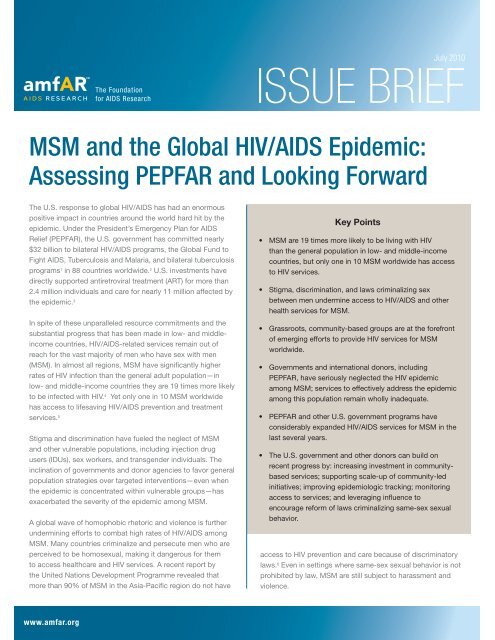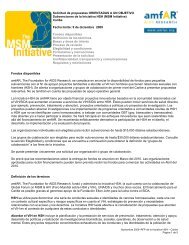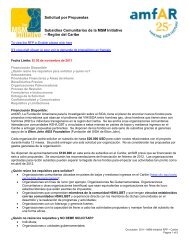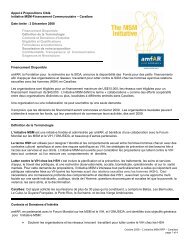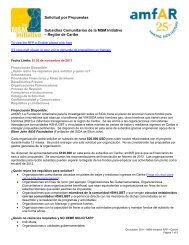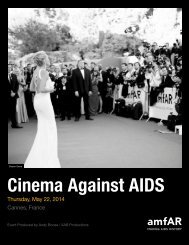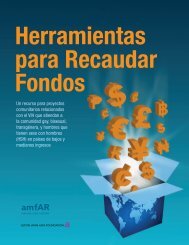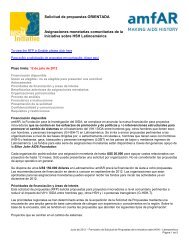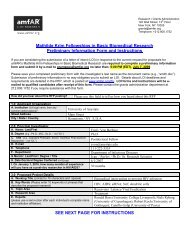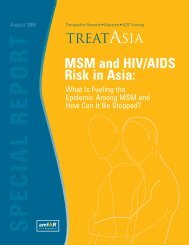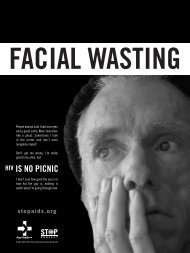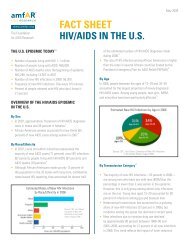Issue Brief: MSM and the Global HIV/AIDS Epidemic - amfAR
Issue Brief: MSM and the Global HIV/AIDS Epidemic - amfAR
Issue Brief: MSM and the Global HIV/AIDS Epidemic - amfAR
You also want an ePaper? Increase the reach of your titles
YUMPU automatically turns print PDFs into web optimized ePapers that Google loves.
The Foundation<br />
for <strong>AIDS</strong> Research<br />
July 2010<br />
ISSUE BRIEF<br />
<strong>MSM</strong> <strong>and</strong> <strong>the</strong> <strong>Global</strong> <strong>HIV</strong>/<strong>AIDS</strong> <strong>Epidemic</strong>:<br />
Assessing PEPFAR <strong>and</strong> Looking Forward<br />
The U.S. response to global <strong>HIV</strong>/<strong>AIDS</strong> has had an enormous<br />
positive impact in countries around <strong>the</strong> world hard hit by <strong>the</strong><br />
epidemic. Under <strong>the</strong> President’s Emergency Plan for <strong>AIDS</strong><br />
Relief (PEPFAR), <strong>the</strong> U.S. government has committed nearly<br />
$32 billion to bilateral <strong>HIV</strong>/<strong>AIDS</strong> programs, <strong>the</strong> <strong>Global</strong> Fund to<br />
Fight <strong>AIDS</strong>, Tuberculosis <strong>and</strong> Malaria, <strong>and</strong> bilateral tuberculosis<br />
programs 1 in 88 countries worldwide. 2 U.S. investments have<br />
directly supported antiretroviral treatment (ART) for more than<br />
2.4 million individuals <strong>and</strong> care for nearly 11 million affected by<br />
<strong>the</strong> epidemic. 3<br />
In spite of <strong>the</strong>se unparalleled resource commitments <strong>and</strong> <strong>the</strong><br />
substantial progress that has been made in low- <strong>and</strong> middleincome<br />
countries, <strong>HIV</strong>/<strong>AIDS</strong>-related services remain out of<br />
reach for <strong>the</strong> vast majority of men who have sex with men<br />
(<strong>MSM</strong>). In almost all regions, <strong>MSM</strong> have significantly higher<br />
rates of <strong>HIV</strong> infection than <strong>the</strong> general adult population—in<br />
low- <strong>and</strong> middle-income countries <strong>the</strong>y are 19 times more likely<br />
to be infected with <strong>HIV</strong>. 4 Yet only one in 10 <strong>MSM</strong> worldwide<br />
has access to lifesaving <strong>HIV</strong>/<strong>AIDS</strong> prevention <strong>and</strong> treatment<br />
services. 5<br />
Stigma <strong>and</strong> discrimination have fueled <strong>the</strong> neglect of <strong>MSM</strong><br />
<strong>and</strong> o<strong>the</strong>r vulnerable populations, including injection drug<br />
users (IDUs), sex workers, <strong>and</strong> transgender individuals. The<br />
inclination of governments <strong>and</strong> donor agencies to favor general<br />
population strategies over targeted interventions—even when<br />
<strong>the</strong> epidemic is concentrated within vulnerable groups—has<br />
exacerbated <strong>the</strong> severity of <strong>the</strong> epidemic among <strong>MSM</strong>.<br />
A global wave of homophobic rhetoric <strong>and</strong> violence is fur<strong>the</strong>r<br />
undermining efforts to combat high rates of <strong>HIV</strong>/<strong>AIDS</strong> among<br />
<strong>MSM</strong>. Many countries criminalize <strong>and</strong> persecute men who are<br />
perceived to be homosexual, making it dangerous for <strong>the</strong>m<br />
to access healthcare <strong>and</strong> <strong>HIV</strong> services. A recent report by<br />
<strong>the</strong> United Nations Development Programme revealed that<br />
more than 90% of <strong>MSM</strong> in <strong>the</strong> Asia-Pacific region do not have<br />
Key Points<br />
• <strong>MSM</strong> are 19 times more likely to be living with <strong>HIV</strong><br />
than <strong>the</strong> general population in low- <strong>and</strong> middle-income<br />
countries, but only one in 10 <strong>MSM</strong> worldwide has access<br />
to <strong>HIV</strong> services.<br />
• Stigma, discrimination, <strong>and</strong> laws criminalizing sex<br />
between men undermine access to <strong>HIV</strong>/<strong>AIDS</strong> <strong>and</strong> o<strong>the</strong>r<br />
health services for <strong>MSM</strong>.<br />
• Grassroots, community-based groups are at <strong>the</strong> forefront<br />
of emerging efforts to provide <strong>HIV</strong> services for <strong>MSM</strong><br />
worldwide.<br />
• Governments <strong>and</strong> international donors, including<br />
PEPFAR, have seriously neglected <strong>the</strong> <strong>HIV</strong> epidemic<br />
among <strong>MSM</strong>; services to effectively address <strong>the</strong> epidemic<br />
among this population remain wholly inadequate.<br />
• PEPFAR <strong>and</strong> o<strong>the</strong>r U.S. government programs have<br />
considerably exp<strong>and</strong>ed <strong>HIV</strong>/<strong>AIDS</strong> services for <strong>MSM</strong> in <strong>the</strong><br />
last several years.<br />
• The U.S. government <strong>and</strong> o<strong>the</strong>r donors can build on<br />
recent progress by: increasing investment in communitybased<br />
services; supporting scale-up of community-led<br />
initiatives; improving epidemiologic tracking; monitoring<br />
access to services; <strong>and</strong> leveraging influence to<br />
encourage reform of laws criminalizing same-sex sexual<br />
behavior.<br />
access to <strong>HIV</strong> prevention <strong>and</strong> care because of discriminatory<br />
laws. 6 Even in settings where same-sex sexual behavior is not<br />
prohibited by law, <strong>MSM</strong> are still subject to harassment <strong>and</strong><br />
violence.<br />
www.amfar.org
2<br />
<strong>MSM</strong> <strong>and</strong> <strong>the</strong> <strong>Global</strong> <strong>HIV</strong>/<strong>AIDS</strong> <strong>Epidemic</strong>: Assessing PEPFAR <strong>and</strong> Looking Forward<br />
Enormous opportunities exist for<br />
international donor programs, including<br />
PEPFAR, <strong>and</strong> for governments in affected<br />
countries to complement <strong>and</strong> augment<br />
grassroots efforts.<br />
While many barriers to <strong>HIV</strong> services for <strong>MSM</strong> are situated at<br />
<strong>the</strong> country level, PEPFAR’s original authorization in 2004<br />
imposed requirements on resource allocation that for years<br />
hindered <strong>HIV</strong> prevention efforts among vulnerable populations. 7<br />
In <strong>the</strong> last two years <strong>the</strong>re have been notable advances,<br />
including a significant expansion in PEPFAR-supported <strong>MSM</strong><br />
programming <strong>and</strong> important commitments from PEPFAR<br />
leadership in Washington. Still, as this analysis shows, <strong>HIV</strong>/<br />
<strong>AIDS</strong> services through PEPFAR <strong>and</strong> o<strong>the</strong>r providers remain<br />
inadequate to address <strong>the</strong> epidemic among <strong>MSM</strong>. Severely<br />
lacking are interventions to tackle <strong>the</strong> formidable social,<br />
religious, legal, <strong>and</strong> policy barriers that st<strong>and</strong> between <strong>MSM</strong><br />
<strong>and</strong> access to <strong>HIV</strong> health services.<br />
Grassroots, community-based organizations remain at <strong>the</strong><br />
forefront of vibrant, emerging responses, leading efforts to<br />
provide urgently needed <strong>HIV</strong>/<strong>AIDS</strong> services to <strong>MSM</strong> <strong>and</strong><br />
o<strong>the</strong>r vulnerable groups throughout <strong>the</strong> world. But enormous<br />
opportunities exist for international donor programs, including<br />
PEPFAR, <strong>and</strong> for governments in affected countries to<br />
complement <strong>and</strong> augment <strong>the</strong>se efforts. By doing so, <strong>the</strong>y<br />
can make important strides against <strong>the</strong> <strong>AIDS</strong> epidemic <strong>and</strong><br />
significantly streng<strong>the</strong>n global health programming.<br />
KEY FINDINGS ON THE <strong>MSM</strong> EPIDEMIC<br />
AND <strong>HIV</strong>/<strong>AIDS</strong> PROGRAMMING IN PEPFAR<br />
COUNTRIES<br />
This issue brief provides a detailed analysis of PEPFAR’s<br />
response to <strong>MSM</strong> in eight countries: China, Côte d’Ivoire,<br />
Guatemala, Jamaica, Malawi, Ukraine, Vietnam, <strong>and</strong> Zambia.<br />
The eight countries represent a range of epidemiologic,<br />
geographic, <strong>and</strong> contextual l<strong>and</strong>scapes. The analysis is based<br />
on publicly available documents <strong>and</strong> interviews with U.S.<br />
government staff, public health experts, healthcare <strong>and</strong> service<br />
providers, <strong>and</strong> members of civil society. It combines available<br />
data <strong>and</strong> estimates in journal articles <strong>and</strong> government reports<br />
with information from interviews to develop <strong>the</strong> most accurate<br />
assessment possible. The research reveals some of <strong>the</strong><br />
challenges faced by global funders in providing services, as<br />
well as <strong>the</strong> paucity of <strong>MSM</strong> programming in some of <strong>the</strong> most<br />
severely affected countries in <strong>the</strong> world. The country profiles<br />
also offer numerous examples of exp<strong>and</strong>ed investment in<br />
services <strong>and</strong> promising new initiatives.<br />
A Note on Terminology<br />
• Men who have sex with men is a term that includes all<br />
men who engage in consensual male-male sex, including<br />
those who identify as gay, bisexual, or heterosexual,<br />
<strong>and</strong> including men who are sex workers. Some <strong>MSM</strong><br />
have concurrent sexual relationships with both men <strong>and</strong><br />
women.<br />
• Transgender describes people whose innate sense<br />
of gender identity is different from <strong>the</strong> male or female<br />
gender assigned to <strong>the</strong>m at birth.<br />
• <strong>MSM</strong> <strong>and</strong> transgender categories include a wide<br />
range of identities, roles, <strong>and</strong> experiences, which can<br />
vary considerably from one culture to ano<strong>the</strong>r; many<br />
people transition in <strong>and</strong> out of behaviors <strong>and</strong> identities<br />
throughout <strong>the</strong>ir lives. Recognizing this complexity is<br />
critical to addressing <strong>the</strong> barriers that often block access<br />
to healthcare for <strong>the</strong>se populations, <strong>and</strong> to developing<br />
effective <strong>HIV</strong> interventions.<br />
Striking limitations exist in <strong>the</strong> quantity <strong>and</strong> quality of available<br />
information, including <strong>HIV</strong> prevalence among <strong>MSM</strong> <strong>and</strong> details<br />
on targeted program <strong>and</strong> service availaibility. In national<br />
statistics <strong>and</strong> some country-level PEPFAR data, <strong>MSM</strong> are<br />
often subsumed under <strong>the</strong> general category of “most-at-risk<br />
populations,” making it difficult to determine which services are<br />
targeting <strong>MSM</strong> specifically.<br />
While <strong>the</strong> <strong>AIDS</strong> epidemic <strong>and</strong> PEPFAR’s responses are different<br />
in each of <strong>the</strong> eight countries, several overarching <strong>the</strong>mes<br />
emerge from this analysis:<br />
• High infection rates: Where estimates are available—<strong>and</strong><br />
often little research has been conducted—<strong>HIV</strong> prevalence<br />
among <strong>MSM</strong> is very high. In all eight countries reviewed,<br />
<strong>HIV</strong> prevalence is significantly higher among <strong>MSM</strong> than<br />
<strong>the</strong> general population (see Figure 1). This is true even in<br />
generalized epidemic settings such as Malawi <strong>and</strong> Côte<br />
d’Ivoire, where <strong>HIV</strong> prevalence among <strong>MSM</strong> is reported to<br />
be as high as 21.4% <strong>and</strong> 18.5% respectively. 30,52<br />
• Incomplete epidemiologic data: In many countries,<br />
epidemiologic data on <strong>MSM</strong> are nonexistent, out of date,<br />
or inconclusive. In Côte d’Ivoire <strong>and</strong> Zambia, for example,<br />
www.amfar.org
<strong>MSM</strong> <strong>and</strong> <strong>the</strong> <strong>Global</strong> <strong>HIV</strong>/<strong>AIDS</strong> <strong>Epidemic</strong>: Assessing PEPFAR <strong>and</strong> Looking Forward 3<br />
small sample sizes compromise <strong>the</strong> value of existing<br />
data. Many governments do not include <strong>MSM</strong> in routine<br />
<strong>HIV</strong>/<strong>AIDS</strong> surveillance <strong>and</strong> do not systematically ga<strong>the</strong>r<br />
or report data on <strong>MSM</strong> as a discrete group. None of<br />
<strong>the</strong> countries profiled officially tracks <strong>HIV</strong> incidence or<br />
<strong>HIV</strong> exposure risks among <strong>MSM</strong>—although most report<br />
results from sentinel studies in <strong>the</strong> 2010 UNGASS reports.<br />
While PEPFAR is supporting several research studies, for<br />
example in Côte d’Ivoire <strong>and</strong> Malawi, lack of funding <strong>and</strong><br />
political will undermine efforts to streng<strong>the</strong>n surveillance<br />
mechanisms that would improve underst<strong>and</strong>ing of <strong>HIV</strong><br />
prevalence among <strong>MSM</strong>.<br />
• Limited service coverage for <strong>MSM</strong>: Of <strong>the</strong> $2.2 billion<br />
spent in <strong>the</strong> eight countries between FY 2004 <strong>and</strong> FY 2009,<br />
<strong>the</strong> amount dedicated to <strong>MSM</strong>-specific interventions is<br />
indeterminate. PEPFAR does not report specifically on<br />
program financing that targets <strong>MSM</strong>, <strong>and</strong> tracking <strong>the</strong><br />
flow of resources from U.S. agencies through <strong>the</strong> various<br />
funded organizations has proven to be extremely difficult.<br />
Still, key informants consistently remarked on <strong>the</strong> limited<br />
availability of <strong>HIV</strong>-related services for <strong>MSM</strong> in all countries<br />
surveyed here. It is also clear that in some settings, progress<br />
has been made through PEPFAR-funded <strong>and</strong> communityled<br />
activities, for example in China, Côte d’Ivoire, Ukraine,<br />
<strong>and</strong> Vietnam. Progress is being made in o<strong>the</strong>r countries not<br />
examined in this report. In Nigeria, for example, Heartl<strong>and</strong><br />
Alliance has launched a USAID-funded integrated <strong>MSM</strong> <strong>HIV</strong><br />
prevention program. 8 In <strong>the</strong> eight countries examined here,<br />
community-based organizations are operating on <strong>the</strong> front<br />
lines of <strong>the</strong> <strong>AIDS</strong> p<strong>and</strong>emic, serving <strong>the</strong> <strong>HIV</strong>-related needs of<br />
<strong>MSM</strong> <strong>and</strong> o<strong>the</strong>r vulnerable groups.<br />
Although this issue brief does not examine transgenderspecific<br />
programs, research suggests that service coverage<br />
for this population is extremely limited. Studies indicate that<br />
transgender communities in many settings are particularly<br />
vulnerable to <strong>HIV</strong>, <strong>and</strong> scale-up of <strong>HIV</strong> related services for<br />
<strong>the</strong>se communities is needed. 9,10<br />
• Widespread criminalization <strong>and</strong> severe punishment:<br />
Stigma, discrimination, <strong>and</strong> criminalization are major barriers<br />
limiting provision <strong>and</strong> uptake of <strong>HIV</strong> services for <strong>MSM</strong>. Three<br />
of <strong>the</strong> eight countries examined have laws criminalizing<br />
homosexuality. Consensual male-to-male sex is punishable<br />
by up to 14 years imprisonment in Malawi <strong>and</strong> Zambia,<br />
<strong>and</strong> by imprisonment <strong>and</strong> hard labor for up to 10 years in<br />
Jamaica. 23 All told, laws prohibiting same-sex sexual activity<br />
between consenting adults are on <strong>the</strong> books in more than<br />
half (48 of 88) of <strong>the</strong> countries with PEPFAR programs,<br />
including three that impose <strong>the</strong> death penalty (Mauritania,<br />
Sudan, <strong>and</strong> Yemen). 23 Even in countries without criminal<br />
Figure 1: <strong>HIV</strong> Prevalence Among <strong>MSM</strong> <strong>and</strong> General Populations 63<br />
penalties—such as China, Guatemala, <strong>and</strong> Ukraine—denial<br />
of full <strong>and</strong> equal rights for <strong>MSM</strong> <strong>and</strong> o<strong>the</strong>r sexual minorities<br />
exacerbates <strong>HIV</strong> risk by driving <strong>MSM</strong> underground <strong>and</strong><br />
beyond <strong>the</strong> reach of <strong>HIV</strong> information <strong>and</strong> health services.<br />
• Civil society as a driving force for change: In all of <strong>the</strong><br />
countries examined here, community-based efforts to<br />
advance <strong>MSM</strong> health <strong>and</strong> rights have been central to <strong>the</strong><br />
successes that have been achieved. In countries such<br />
as Guatemala, Jamaica, <strong>and</strong> Zambia, local <strong>and</strong> national<br />
governments do not explicitly prioritize <strong>MSM</strong> in <strong>the</strong>ir <strong>HIV</strong>/<br />
<strong>AIDS</strong> response <strong>and</strong> dedicate only limited resources for<br />
interventions targeting this population. Consequently, <strong>the</strong><br />
<strong>AIDS</strong> response has depended on support from donors<br />
working in partnership with local nongovernmental<br />
organizations (NGOs), <strong>MSM</strong>-friendly champions in decisionmaking<br />
positions, <strong>and</strong> civil society. In all countries examined<br />
here, many NGOs that serve <strong>MSM</strong> appear to be highly<br />
motivated but need technical support in areas such as fiscal<br />
<strong>and</strong> personnel management, strategic planning, <strong>and</strong> <strong>the</strong><br />
provision of basic public health information.<br />
Laws prohibiting same-sex sexual activity<br />
between consenting adults are on <strong>the</strong><br />
books in more than half of <strong>the</strong> countries<br />
with PEPFAR programs, including three<br />
that impose <strong>the</strong> death penalty.<br />
www.amfar.org
4<br />
<strong>MSM</strong> <strong>and</strong> <strong>the</strong> <strong>Global</strong> <strong>HIV</strong>/<strong>AIDS</strong> <strong>Epidemic</strong>: Assessing PEPFAR <strong>and</strong> Looking Forward<br />
REACHING <strong>MSM</strong>: RECOMMENDATIONS FOR<br />
PROVIDERS AND GOVERNMENTS<br />
The urgency of scaling up <strong>HIV</strong> programs to reach <strong>MSM</strong> is<br />
widely recognized, even as programmers <strong>and</strong> funders struggle<br />
to implement long-overdue interventions. Because <strong>the</strong> <strong>HIV</strong>/<br />
<strong>AIDS</strong> epidemic <strong>and</strong> <strong>the</strong> cultural, political, <strong>and</strong> economic forces<br />
that shape it are unique to every country, no two national<br />
responses can be exactly <strong>the</strong> same. Funders <strong>and</strong> program<br />
implementers need to be flexible in <strong>the</strong>ir approaches to local<br />
epidemics <strong>and</strong> social contexts. None<strong>the</strong>less, research <strong>and</strong><br />
direct experience point to a series of recommendations that<br />
are broadly applicable to <strong>HIV</strong>/<strong>AIDS</strong> funders <strong>and</strong> policy makers.<br />
<strong>Global</strong> institutions such as <strong>the</strong> Joint United Nations<br />
Programme on <strong>HIV</strong>/<strong>AIDS</strong> (UN<strong>AIDS</strong>) <strong>and</strong> <strong>the</strong> World Health<br />
Organization (WHO) recommend that certain core components<br />
be included in a comprehensive package of services for<br />
<strong>MSM</strong>: 12,13,14,15,16<br />
• <strong>MSM</strong> peer outreach <strong>and</strong> engagement in <strong>HIV</strong> care <strong>and</strong><br />
treatment services;<br />
• Trained health providers with <strong>the</strong> specific knowledge,<br />
attitudes, <strong>and</strong> skills necessary for working with <strong>MSM</strong>, along<br />
with clinics that are <strong>MSM</strong>-friendly (with confidential intake,<br />
record-keeping, <strong>and</strong> follow-up);<br />
In Malawi, a Matter of Life <strong>and</strong> Death<br />
Stigma <strong>and</strong> discrimination toward <strong>MSM</strong> are on <strong>the</strong> rise<br />
in Malawi, driven in part by <strong>the</strong> case of two men who<br />
were arrested in late 2009 after publicly celebrating <strong>the</strong>ir<br />
engagement. Despite a presidential pardon in May 2010,<br />
<strong>the</strong> arrest, trial, <strong>and</strong> imprisonment of Steven Monjeza <strong>and</strong><br />
Tiwonge Chimbalanga have generated widespread fear<br />
among <strong>MSM</strong> seeking health services <strong>and</strong> organizations<br />
that provide those services. In February 2010, <strong>the</strong> Center<br />
for <strong>the</strong> Development of People (CEDEP), which provides<br />
<strong>HIV</strong> testing, counseling, <strong>and</strong> outreach to <strong>MSM</strong> <strong>and</strong> o<strong>the</strong>r<br />
vulnerable groups in Malawi, was forced to close its office<br />
in Blantyre <strong>and</strong> relocate to <strong>the</strong> capital, Lilongwe, after<br />
two health workers from <strong>the</strong> organization were arrested.<br />
With <strong>the</strong> flare-up of homophobia in Malawi, CEDEP is<br />
facing new challenges in scaling up <strong>HIV</strong>/<strong>AIDS</strong>-related<br />
interventions for <strong>MSM</strong>.<br />
• <strong>HIV</strong>/sexually transmitted infection (STI) diagnostics<br />
at clinics serving <strong>MSM</strong>, including rapid tests for <strong>HIV</strong> <strong>and</strong><br />
syphilis, screening for gonorrhea, <strong>and</strong> Pap smears to<br />
screen for anal dysplasia;<br />
• Immunizations against hepatitis A, hepatitis B, <strong>and</strong><br />
human papilloma virus;<br />
• Promotion <strong>and</strong> distribution of water-based lubricants<br />
<strong>and</strong> condoms; <strong>and</strong><br />
• Supportive interventions that include capacity<br />
building, community mobilization, stigma reduction<br />
programs, income-generating activities, <strong>and</strong> advocacy<br />
for legal/policy reform <strong>and</strong> human rights protections.<br />
Without <strong>MSM</strong>-specific <strong>HIV</strong>/<strong>AIDS</strong> services, <strong>MSM</strong> <strong>and</strong><br />
transgender people can receive <strong>HIV</strong> services only through<br />
general health services. But many <strong>MSM</strong> are reluctant to<br />
disclose <strong>the</strong>ir sexual activities to healthcare workers who are<br />
untrained on <strong>MSM</strong> sexual health issues, limiting <strong>the</strong>ir access<br />
to <strong>HIV</strong> prevention interventions, voluntary <strong>HIV</strong> testing, <strong>and</strong><br />
o<strong>the</strong>r recommended health services. 17<br />
Governments <strong>and</strong> donors have a responsibility to assess <strong>the</strong><br />
degree to which government-run health facilities are able to<br />
meet <strong>the</strong> needs of <strong>MSM</strong> <strong>and</strong> o<strong>the</strong>r vulnerable populations. In<br />
some cases, community-based NGOs are better positioned<br />
to deliver services to <strong>MSM</strong> than government agencies. In<br />
o<strong>the</strong>rs, clients may prefer to obtain services from public<br />
health systems.<br />
RECOMMENDATIONS TO ADVANCE PEPFAR<br />
PROGRAMMING<br />
PEPFAR’s recent efforts to address <strong>HIV</strong> among <strong>MSM</strong> have<br />
been limited but hold substantial promise. Legislation<br />
reauthorizing PEPFAR in 2008 recognized <strong>the</strong> importance<br />
of addressing <strong>the</strong> <strong>HIV</strong> service needs of <strong>MSM</strong>, calling for<br />
“appropriate <strong>HIV</strong>/<strong>AIDS</strong> education programs <strong>and</strong> training<br />
targeted to prevent <strong>the</strong> transmission of <strong>HIV</strong> among [<strong>MSM</strong>].” 18<br />
PEPFAR’s Five-Year Strategy, released in December 2009,<br />
acknowledges <strong>the</strong> disproportionate impact of <strong>HIV</strong> on <strong>MSM</strong><br />
<strong>and</strong> notes that governments are “often reluctant to engage<br />
in outreach to <strong>the</strong>se communities.” The strategy pledges<br />
to address stigma <strong>and</strong> discrimination against <strong>MSM</strong> <strong>and</strong> to<br />
support targeted <strong>HIV</strong> prevention <strong>and</strong> treatment services. 19<br />
Based on <strong>the</strong> PEPFAR country analyses in this report, a<br />
number of recommendations can be made for actions<br />
to streng<strong>the</strong>n this nascent response. With <strong>the</strong> epidemic<br />
www.amfar.org
<strong>MSM</strong> <strong>and</strong> <strong>the</strong> <strong>Global</strong> <strong>HIV</strong>/<strong>AIDS</strong> <strong>Epidemic</strong>: Assessing PEPFAR <strong>and</strong> Looking Forward 5<br />
Governments <strong>and</strong> donors have a<br />
responsibility to assess <strong>the</strong> degree to<br />
which government-run health facilities<br />
are able to meet <strong>the</strong> needs of <strong>MSM</strong> <strong>and</strong><br />
o<strong>the</strong>r vulnerable populations.<br />
among <strong>MSM</strong> continuing to exp<strong>and</strong>, PEPFAR <strong>and</strong> <strong>the</strong> Obama<br />
administration’s <strong>Global</strong> Health Initiative must take <strong>the</strong> following<br />
concrete steps to more effectively reach <strong>MSM</strong> <strong>and</strong> vulnerable<br />
populations:<br />
1. Create an <strong>MSM</strong>-specific strategic fund to provide<br />
resources for PEPFAR countries beyond <strong>the</strong>ir baseline<br />
allocations. This fund should support research in countries<br />
with limited data, refinement of <strong>MSM</strong> population size<br />
estimates, <strong>and</strong> scale-up of proven cost-effective programs<br />
in countries with existing programs such as China, Ukraine,<br />
<strong>and</strong> Vietnam.<br />
2. Substantially increase financial support for<br />
community-based <strong>MSM</strong> groups <strong>and</strong> NGOs to provide<br />
<strong>HIV</strong> services to <strong>MSM</strong> <strong>and</strong> advocate for human rights.<br />
Beyond program support, funding should be dedicated to<br />
developing organizational capacity for front-line community<br />
groups, including core development such as fiscal <strong>and</strong><br />
personnel management, strategic planning, <strong>and</strong> computer<br />
<strong>and</strong> social media training.<br />
3. Develop policies to guide expansion <strong>and</strong> uptake of a<br />
comprehensive package of health services tailored to <strong>the</strong><br />
needs of <strong>MSM</strong>, both through general health systems <strong>and</strong><br />
targeted initiatives that can be accessed by people who<br />
may not feel safe using general health services. In many<br />
cases, NGOs will be better positioned to deliver services to<br />
<strong>MSM</strong> than government-run public health settings.<br />
4. Provide training <strong>and</strong> guidance to help providers in<br />
local health sectors respond to <strong>the</strong> specific needs of <strong>MSM</strong><br />
<strong>and</strong> offer appropriate services. Training should also be<br />
conducted for all U.S. government health <strong>and</strong> development<br />
staff, implementing partner agencies (both global <strong>and</strong> local),<br />
<strong>and</strong> key stakeholders.<br />
5. Help national <strong>AIDS</strong> control agencies <strong>and</strong> health<br />
ministries underst<strong>and</strong> <strong>and</strong> prioritize <strong>the</strong> health needs of<br />
<strong>MSM</strong> using PEPFAR Partnership Frameworks, Partnership<br />
Framework Implementation Plans, <strong>and</strong> o<strong>the</strong>r agreements<br />
between <strong>the</strong> U.S. government <strong>and</strong> PEPFAR countries.<br />
Governments should prioritize streng<strong>the</strong>ning surveillance<br />
to more closely track <strong>HIV</strong> among <strong>MSM</strong>, <strong>and</strong> to improve<br />
underst<strong>and</strong>ing of <strong>the</strong> social <strong>and</strong> behavioral risk factors that<br />
should inform programming.<br />
6. Appoint an <strong>MSM</strong> coordinator at <strong>the</strong> Office of<br />
<strong>the</strong> <strong>Global</strong> <strong>AIDS</strong> Coordinator (OGAC) to track <strong>and</strong><br />
report <strong>MSM</strong>-specific PEPFAR programming, budget<br />
allocations, <strong>and</strong> policy <strong>and</strong> program outcomes. The<br />
<strong>MSM</strong> coordinator should provide timely, detailed, <strong>and</strong><br />
comprehensive information on <strong>the</strong> budgeting, delivery, <strong>and</strong><br />
monitoring of PEPFAR-supported <strong>MSM</strong> programs. PEPFAR<br />
should make <strong>the</strong>se data publicly available.<br />
7. Increase financial <strong>and</strong> technical support for<br />
operations research that can identify interventions<br />
capable of reaching diverse <strong>MSM</strong> communities in different<br />
countries, <strong>and</strong> disseminate results to inform national <strong>and</strong><br />
regional policies.<br />
8. Work with national governments, civil society<br />
coalitions, <strong>and</strong> multilateral partners including European<br />
governments, UN agencies, <strong>the</strong> World Bank, <strong>and</strong> <strong>the</strong><br />
<strong>Global</strong> Fund to increase global resources for <strong>HIV</strong>/<strong>AIDS</strong> <strong>and</strong><br />
related programs targeting <strong>MSM</strong>, <strong>and</strong> facilitate <strong>the</strong> direct<br />
<strong>and</strong> meaningful involvement of <strong>MSM</strong> in global <strong>and</strong> national<br />
decision-making bodies.<br />
9. Address <strong>the</strong> unique vulnerability of transgender<br />
people by exp<strong>and</strong>ing research <strong>and</strong> targeted <strong>HIV</strong><br />
interventions for this population.<br />
10. Use diplomatic <strong>and</strong> financing leverage to encourage<br />
recipient countries to identify policy changes that impede<br />
effective <strong>HIV</strong> programs; repeal laws that criminalize<br />
consensual adult same-sex sexual practice; <strong>and</strong> reform<br />
policies that fuel stigma <strong>and</strong> discrimination.<br />
www.amfar.org
6<br />
<strong>MSM</strong> <strong>and</strong> <strong>the</strong> <strong>Global</strong> <strong>HIV</strong>/<strong>AIDS</strong> <strong>Epidemic</strong>: Assessing PEPFAR <strong>and</strong> Looking Forward<br />
<strong>MSM</strong> AND <strong>HIV</strong> IN EIGHT PEPFAR FOCUS<br />
COUNTRIES<br />
The country profiles that follow provide an overview of <strong>the</strong><br />
most recent information available about <strong>the</strong> status of <strong>MSM</strong> in<br />
relation to <strong>the</strong> fight against <strong>HIV</strong> in eight PEPFAR countries. This<br />
analysis reviews <strong>the</strong> best available epidemiology, provides a<br />
snapshot of PEPFAR-supported services for <strong>MSM</strong>, notes <strong>the</strong><br />
legal status of male-male sexual behavior, <strong>and</strong> summarizes<br />
priorities for improving <strong>the</strong> <strong>HIV</strong> response. The information on<br />
programming is based on a broad range of sources, including<br />
publicly available documents such as:<br />
• 2008 <strong>and</strong> 2009 PEPFAR Country Operating Plans (COPs)<br />
• Partnership Framework Agreements<br />
• Partnership Framework Implementation Plans<br />
• 2010 UNGASS country progress reports<br />
• Peer review <strong>and</strong> public health literature.<br />
In addition, 23 interviews with key informants were conducted<br />
between April <strong>and</strong> June 2010 by <strong>amfAR</strong> staff in Washington,<br />
D.C., including:<br />
• Field-based PEPFAR staff from USAID <strong>and</strong> <strong>the</strong> Centers for<br />
Disease Control <strong>and</strong> Prevention (CDC)<br />
• Country <strong>and</strong> program managers for major PEPFARsupported<br />
NGOs<br />
• Leaders from front-line community groups operating in each<br />
of <strong>the</strong> eight countries<br />
• Leading epidemiologists <strong>and</strong> experts on <strong>MSM</strong> issues.<br />
Photo credit: Piotr Bizior/SXC<br />
CHINA<br />
Snapshot of <strong>the</strong> epidemic<br />
With a 0.057% <strong>HIV</strong><br />
prevalence among <strong>the</strong><br />
general population, China<br />
is experiencing a lowprevalence<br />
epidemic, with<br />
higher prevalence in some<br />
regions. 20 At <strong>the</strong> end of<br />
2009, an estimated 740,000<br />
people were living with <strong>HIV</strong>, of whom 48,000 were newly<br />
infected. 20<br />
Estimates from 2009 indicate that heterosexual transmission<br />
accounted for 42.2% of new infections <strong>and</strong> male-male sexual<br />
transmission, 32.5%. 20 The latter figure represents a significant<br />
increase over 2007, when male-male transmission accounted<br />
for 12.2% of new cases. 20 A 2008 national <strong>MSM</strong> epidemiological<br />
survey carried out in 61 major cities reported an overall <strong>HIV</strong><br />
prevalence of 5%, but <strong>HIV</strong> prevalence among <strong>MSM</strong> varies<br />
considerably in different parts of China. 20 Estimates range from<br />
1.5% in Shanghai, to 5% in Shenzen, 8.5% in Chongqing,<br />
<strong>and</strong> 9.1% in Chengdu. 21 More recent studies have shown <strong>HIV</strong><br />
incidence rapidly increasing among <strong>MSM</strong> in China, including<br />
Nanjing, where a study reported an incidence of 5.12 per 100<br />
person-years. 22<br />
Legal status<br />
China does not criminalize homosexual activity. 23 However, laws<br />
in China do not bar discrimination or specifically protect <strong>MSM</strong><br />
<strong>and</strong> o<strong>the</strong>r sexual minorities, which is a reality that presents a<br />
barrier to program scale-up in certain areas, according to key<br />
informants.<br />
Budget<br />
PEPFAR-approved FY09 funding for China is $10.3 million. 24<br />
Since 2004, PEPFAR has invested nearly $40 million to support<br />
<strong>HIV</strong> programming in China. 24 Financial information on <strong>MSM</strong>specific<br />
programming is unavailable.<br />
Interventions<br />
China’s post-SARS leadership is alert to <strong>the</strong> pitfalls of neglecting<br />
<strong>the</strong> country’s public healthcare system. 25 The government’s<br />
change in attitude has ushered in increased spending on<br />
public health <strong>and</strong> improved <strong>HIV</strong>-related policies. 25 Government<br />
funding was mobilized specifically for <strong>MSM</strong> in 2004 <strong>and</strong> again<br />
in 2007, when <strong>MSM</strong> were added to China’s national strategic<br />
framework. 13<br />
www.amfar.org
0 355<br />
710 Miles<br />
0 355 710 KM<br />
<strong>MSM</strong> <strong>and</strong> <strong>the</strong> <strong>Global</strong> <strong>HIV</strong>/<strong>AIDS</strong> <strong>Epidemic</strong>: Assessing PEPFAR <strong>and</strong> Looking Forward 7<br />
PEPFAR’s involvement has intensified in recent years, including<br />
support for a national <strong>MSM</strong> epidemiological survey <strong>and</strong> <strong>the</strong><br />
development of a “minimum package of services” model<br />
for <strong>MSM</strong>. PEPFAR has also supported <strong>MSM</strong>-friendly STI<br />
clinics <strong>and</strong> <strong>the</strong> development of a model for clinic-based peerdriven<br />
behavioral interventions addressing STIs in Beijing,<br />
Heilongjiang, <strong>and</strong> Sh<strong>and</strong>ong. Capacity building with local<br />
partners has involved training local sub-partners, including<br />
community-based groups <strong>and</strong> o<strong>the</strong>r grassroots NGOs, in<br />
behavior change interventions, <strong>HIV</strong> prevention, <strong>and</strong> working with<br />
at-risk populations. 26 In Anhui, Beijing, Heilongjiang, Jiangsu,<br />
Sh<strong>and</strong>ong, <strong>and</strong> Yunnan, where <strong>HIV</strong> prevalence among <strong>MSM</strong><br />
is growing, <strong>the</strong> U.S. supported <strong>the</strong> development of self-help<br />
groups among <strong>HIV</strong>-positive <strong>MSM</strong> networks, which helped to<br />
develop web-based support, telephone hotlines, <strong>and</strong> peer<br />
support services. 26<br />
While <strong>the</strong> U.S. has a relatively small presence in China’s<br />
overall <strong>HIV</strong>/<strong>AIDS</strong> l<strong>and</strong>scape, USAID is currently supporting<br />
Family Health International (FHI), Health Policy Initiative<br />
(HPI)/RTI International, Management Sciences for Health<br />
(MSH), <strong>the</strong> University of North Carolina MEASURE Evaluation<br />
program, Pact (through a sub-grant to <strong>the</strong> International <strong>HIV</strong>/<br />
<strong>AIDS</strong> Alliance), <strong>and</strong> Population Services International (PSI), all<br />
of which provide sub-grants to local governments <strong>and</strong> local<br />
community-based organizations. 26 PEPFAR also supports<br />
<strong>the</strong> Purple Sky Network, which works to reduce <strong>HIV</strong> among<br />
<strong>MSM</strong> by streng<strong>the</strong>ning <strong>MSM</strong> community groups, improving<br />
clinical services, <strong>and</strong> engaging with governments to establish a<br />
supportive environment for <strong>HIV</strong> prevention. 13<br />
Priorities moving forward<br />
Despite efforts supported by <strong>the</strong> U.S. <strong>and</strong> o<strong>the</strong>r donors, many<br />
<strong>MSM</strong> in China remain beyond <strong>the</strong> reach of needed services.<br />
<strong>HIV</strong> interventions reach an estimated 70,000 <strong>MSM</strong> per<br />
month—only around 9% of estimated need. 27 Novel outreach<br />
mechanisms such as online resources need to be designed <strong>and</strong><br />
adopted.<br />
Key informants identified <strong>the</strong> narrow focus of donor programming<br />
<strong>and</strong> inability to support a wide range of appropriate<br />
services as central challenges. Informants stressed <strong>the</strong> need for<br />
donors <strong>and</strong> program implementers to support a diverse range<br />
of options <strong>and</strong> service delivery mechanisms. O<strong>the</strong>r challenges<br />
include increasing <strong>the</strong> capacity of health providers to identify<br />
<strong>and</strong> manage <strong>the</strong> sexual health of <strong>MSM</strong> <strong>and</strong> increasing financial<br />
<strong>and</strong> political support to build <strong>the</strong> capacity of community groups<br />
<strong>and</strong> peer education systems.<br />
CÔTE D’IVOIRE<br />
Snapshot of <strong>the</strong> epidemic<br />
Côte d’Ivoire has a<br />
generalized <strong>HIV</strong> epidemic<br />
with an estimated<br />
prevalence of 3.7% among<br />
adults aged 15 to 49,<br />
one of <strong>the</strong> most severe<br />
outbreaks in West Africa. 28<br />
The epidemic is marked<br />
by striking gender <strong>and</strong> geographic differences, with multiple<br />
populations identified as high risk including serodiscordant<br />
couples, uniformed services <strong>and</strong> ex-combatants, sex workers,<br />
economically vulnerable women <strong>and</strong> girls, truckers <strong>and</strong> mobile<br />
populations, sexually active youth, <strong>and</strong> orphans <strong>and</strong> vulnerable<br />
children. 29 The country’s prolonged political-military crisis<br />
has probably exacerbated <strong>the</strong> epidemic among vulnerable<br />
groups including <strong>MSM</strong>, for whom epidemiological data remain<br />
extremely limited. To date, <strong>the</strong>re has been no nationwide<br />
official study of <strong>MSM</strong> <strong>and</strong> <strong>HIV</strong>. A 2009 study with a sample size<br />
of 54 estimated prevalence to be 18.5%. 30<br />
Legal status<br />
While male-male sexual activity is not prohibited by law,<br />
<strong>MSM</strong> are not able to claim full equal rights, according to<br />
key informants interviewed in country. 23 Moreover, stigma,<br />
discrimination, <strong>and</strong> lack of <strong>MSM</strong>-friendly health staff prevent<br />
many <strong>MSM</strong> from accessing public health services.<br />
Budget<br />
Côte d’Ivoire was one of PEPFAR’s original focus countries.<br />
The U.S. remains <strong>the</strong> largest supporter of <strong>HIV</strong>/<strong>AIDS</strong> programs<br />
in <strong>the</strong> country, with $124.8 million approved for FY09 28,31 Since<br />
2004, PEPFAR has invested nearly $445 million to support<br />
<strong>HIV</strong> programming, 31 but financial information on <strong>MSM</strong>-specific<br />
programming is unavailable. In February 2010, <strong>the</strong> U.S.<br />
Department of Health <strong>and</strong> Human Services <strong>and</strong> <strong>the</strong> CDC<br />
announced a five-year award with a ceiling in <strong>the</strong> first year of<br />
$3.5 million to increase targeted research, capacity building of<br />
local organizations, <strong>and</strong> coverage of <strong>HIV</strong>/<strong>AIDS</strong> prevention <strong>and</strong><br />
care services targeting highly vulnerable populations, including<br />
<strong>MSM</strong>. 32<br />
Interventions<br />
In 2009, <strong>the</strong> CDC supported a preliminary study that included<br />
interviews <strong>and</strong> focus group discussions with 32 <strong>MSM</strong> <strong>and</strong> eight<br />
health service providers in Abidjan. 33 The 2009 COP reports<br />
that PEPFAR will complete an assessment of risk behaviors<br />
www.amfar.org
8<br />
<strong>MSM</strong> <strong>and</strong> <strong>the</strong> <strong>Global</strong> <strong>HIV</strong>/<strong>AIDS</strong> <strong>Epidemic</strong>: Assessing PEPFAR <strong>and</strong> Looking Forward<br />
<strong>and</strong> seroprevalence among <strong>MSM</strong> in Abidjan, <strong>and</strong> “specific<br />
communications <strong>and</strong> interventions for this potential high-risk<br />
group will be developed based on early <strong>and</strong> final results.” 34<br />
A technical review committee has also been established in<br />
country, according to PEPFAR documents, <strong>and</strong> a working<br />
group on highly vulnerable populations, led by <strong>the</strong> Ministry of<br />
Health, is “spearheading <strong>the</strong> national effort, which includes<br />
international organizations, <strong>the</strong> Ministry of Health, <strong>and</strong> multiple<br />
implementing organizations.” 34<br />
Côte d’Ivoire has an extensive bro<strong>the</strong>l- <strong>and</strong> bar-based sex<br />
worker population, which has been targeted for prevention<br />
services from many PEPFAR implementers, primarily FHI.<br />
With PEPFAR support, FHI provides prevention <strong>and</strong> care<br />
services to highly vulnerable populations, working with several<br />
national Ivoirian NGOs, including Clinique de Confiance,<br />
which serves male sex workers. 35 PEPFAR also supports <strong>the</strong><br />
Johns Hopkins Center for Communication Programs (CCP),<br />
which provides technical assistance <strong>and</strong> support to national<br />
ministries <strong>and</strong> implementing partners, to develop communication<br />
tools on <strong>HIV</strong> prevention <strong>and</strong> risk reduction messages for<br />
<strong>MSM</strong>. 36<br />
As reported by U.S. government staff, PEPFAR is funding FHI<br />
in 2010 to conduct <strong>MSM</strong>-related studies in two additional sites<br />
beyond Abidjan, <strong>and</strong> <strong>the</strong> <strong>Global</strong> Fund is proposing plans for<br />
<strong>MSM</strong>-related <strong>HIV</strong> research <strong>and</strong> services. 37<br />
Priorities moving forward<br />
Through its support for <strong>the</strong> government <strong>and</strong> implementing<br />
organizations, PEPFAR has made progress in increasing<br />
<strong>the</strong> visibility of <strong>MSM</strong> in <strong>HIV</strong>/<strong>AIDS</strong> strategic plans. However,<br />
stigma <strong>and</strong> discrimination are widespread, <strong>and</strong> <strong>MSM</strong> are<br />
unable to access health services. To exp<strong>and</strong> programming, key<br />
informants underlined <strong>the</strong> importance of increasing capacity<br />
of local organizations that provide <strong>MSM</strong>-tailored services <strong>and</strong><br />
sensitizing healthcare workers in public of health settings. New<br />
resources are also needed to bring interventions to scale.<br />
GUATEMALA<br />
Snapshot of <strong>the</strong> epidemic<br />
With a general population<br />
<strong>HIV</strong> prevalence of less<br />
than 1%, <strong>the</strong> <strong>HIV</strong>/<strong>AIDS</strong><br />
epidemic in Guatemala<br />
is concentrated among<br />
certain vulnerable<br />
populations, including<br />
<strong>MSM</strong>. 39 According to<br />
Guatemala’s 2010 UNGASS report, transmission is primarily<br />
sexual (94%), followed by mo<strong>the</strong>r to child (5%). 38 In 2009,<br />
<strong>the</strong>re was an average of 17 new <strong>HIV</strong> infections per day <strong>and</strong><br />
reports estimated that two-thirds of people with <strong>HIV</strong> were<br />
unaware of <strong>the</strong>ir status. 38 According to official statistics, 63%<br />
of <strong>the</strong> 20,484 reported cases of <strong>HIV</strong>/<strong>AIDS</strong> are men, a majority<br />
of <strong>the</strong>m between 20 <strong>and</strong> 39 years of age. 38 Migratory work<br />
patterns contribute to <strong>the</strong> spread of Guatemala’s epidemic,<br />
which means that <strong>the</strong> country’s <strong>HIV</strong>-infected population is<br />
concentrated along major transportation routes in urban<br />
areas. 39<br />
National <strong>HIV</strong> prevalence among <strong>MSM</strong> is estimated to be 10%<br />
but higher in some places, including Guatemala City, where it<br />
reaches 18%. 39<br />
Legal status<br />
Male-male sexual activity is not prohibited by law. 23 However,<br />
studies have documented homophobia <strong>and</strong> transphobia within<br />
Guatemalan culture, which cultivates exclusion <strong>and</strong> aggression<br />
towards <strong>MSM</strong> <strong>and</strong> o<strong>the</strong>r sexual minorities. 40 Strong social<br />
pressure to be heterosexual leads many gay <strong>and</strong> bisexual<br />
men to hide sexual identities <strong>and</strong> behavior from girlfriends<br />
or wives. 41 Negative attitudes among healthcare providers<br />
towards <strong>MSM</strong> <strong>and</strong> o<strong>the</strong>r high-risk groups have also been<br />
documented. 42 In <strong>the</strong> first half of 2010,13 transgender people<br />
were murdered in Guatemala. 43<br />
Budget<br />
Approved PEPFAR funding for Guatemala in FY09 is $3.55<br />
million, which includes $2.05 million in direct bilateral funding<br />
<strong>and</strong> $1.5 million through <strong>the</strong> Central America regional<br />
platform. 44 Since 2004, PEPFAR has invested nearly $15.8<br />
million to support <strong>HIV</strong> programming in Guatemala. 44 Financial<br />
information on <strong>MSM</strong>-specific programming is unavailable.<br />
Interventions<br />
USAID, through <strong>the</strong> Central American <strong>HIV</strong>/<strong>AIDS</strong> Regional<br />
Program (G-CAP), has been involved for several years in<br />
addressing <strong>the</strong> epidemic among vulnerable populations<br />
www.amfar.org
<strong>MSM</strong> <strong>and</strong> <strong>the</strong> <strong>Global</strong> <strong>HIV</strong>/<strong>AIDS</strong> <strong>Epidemic</strong>: Assessing PEPFAR <strong>and</strong> Looking Forward 9<br />
through targeted behavior change programs <strong>and</strong> efforts to<br />
improve <strong>the</strong> treatment <strong>and</strong> care skills of medical personnel. 39<br />
Since 1995, USAID has funded PASCA (Central America <strong>HIV</strong>/<br />
<strong>AIDS</strong> Prevention Program) to provide technical assistance to<br />
streng<strong>the</strong>n <strong>and</strong> exp<strong>and</strong> <strong>the</strong> Central American response to <strong>HIV</strong>/<br />
<strong>AIDS</strong>. 45<br />
USAID’s Health Policy Initiative supports efforts to defend<br />
<strong>the</strong> rights of <strong>HIV</strong>-infected <strong>and</strong> -affected individuals, including<br />
<strong>MSM</strong> <strong>and</strong> sex workers. 39 PEPFAR also supports <strong>the</strong> Pan<br />
American Social Marketing Organization (PASMO) through PSI<br />
to improve prevention services, including those aimed at <strong>MSM</strong>,<br />
through social marketing.<br />
Priorities moving forward<br />
PEPFAR’s modest support for <strong>the</strong> Central American region<br />
is not sufficient to meet <strong>the</strong> needs of <strong>MSM</strong> given <strong>the</strong> lack of<br />
funding from o<strong>the</strong>r sources for this work. In Guatemala, <strong>MSM</strong><br />
<strong>and</strong> o<strong>the</strong>r high-risk groups face discrimination that undermines<br />
<strong>the</strong>ir use of public health services. Interviewees identified <strong>the</strong><br />
lack of stigma reduction programs for health providers as a<br />
key barrier to scaling up <strong>HIV</strong> <strong>and</strong> STI prevention services for<br />
hidden <strong>MSM</strong>. U.S. government staff in Guatemala noted <strong>the</strong><br />
government’s missed opportunity to clearly prioritize <strong>MSM</strong><br />
in <strong>the</strong> country’s national <strong>AIDS</strong> plan, presenting a challenge<br />
exp<strong>and</strong>ing <strong>MSM</strong> interventions <strong>and</strong> epidemiological research<br />
in this population. Although <strong>MSM</strong> are not identified explicitly<br />
in <strong>the</strong> Central American <strong>HIV</strong>/<strong>AIDS</strong> Partnership Framework—<br />
signed in March 2010 by <strong>the</strong> U.S. <strong>and</strong> seven countries in<br />
<strong>the</strong> region, including Guatemala—promising provisions for<br />
prevention, health systems streng<strong>the</strong>ning, strategic information<br />
collection, <strong>and</strong> policy-related work are included. 46<br />
JAMAICA<br />
<strong>and</strong> homophobia— continue to fuel <strong>the</strong> transmission of <strong>HIV</strong> in<br />
Jamaica. 47<br />
A 2007 survey found that approximately one in three <strong>MSM</strong> in<br />
Jamaica was <strong>HIV</strong> infected (32%). 48 <strong>MSM</strong> with reportedly low<br />
socio-economic status who had ever been homeless <strong>and</strong> were<br />
victims of physical violence were significantly more likely to be<br />
<strong>HIV</strong> positive. 48 The 2010 UNGASS report notes that <strong>the</strong> sexual<br />
activity of 40% of men with <strong>AIDS</strong> is unknown <strong>and</strong> may reflect<br />
an unwillingness to reveal sexual orientation. 47<br />
Legal status<br />
Male-male sexual activity is illegal <strong>and</strong> subject to imprisonment<br />
for up to 10 years. 23 This perilous legal environment, along with<br />
persistent fears among <strong>MSM</strong> of discrimination <strong>and</strong> violence,<br />
continues to hamper <strong>the</strong> implementation of services for <strong>MSM</strong>. 47<br />
Budget<br />
In Jamaica, approved PEPFAR funding for FY09 is $1 million. 44<br />
Since 2004, PEPFAR has invested nearly $9.38 million in direct<br />
bilateral support to <strong>the</strong> country. 44 Financial information on<br />
<strong>MSM</strong>-specific programming is unavailable.<br />
PEPFAR’s support for <strong>HIV</strong> programming is dwarfed by much<br />
larger contributions from <strong>the</strong> <strong>Global</strong> Fund <strong>and</strong> <strong>the</strong> World Bank.<br />
In April 2010, PEPFAR announced <strong>the</strong> Caribbean Regional<br />
Partnership, a five-year, $100 million strategy encompassing<br />
12 countries <strong>and</strong> two regional organizations. 49<br />
Interventions<br />
According to <strong>the</strong> country’s 2010 UNGASS report, <strong>MSM</strong><br />
activities have been scaled up since 2008, reaching more<br />
than 2,000 men through a combination of outreach work <strong>and</strong><br />
structured workshop interventions led primarily by Jamaica<br />
<strong>AIDS</strong> Support for Life <strong>and</strong> <strong>the</strong> Jamaica Red Cross. 47<br />
Snapshot of <strong>the</strong> epidemic<br />
Jamaica has both generalized<br />
<strong>and</strong> concentrated<br />
epidemics, with an<br />
estimated 1.6% of <strong>the</strong><br />
adult population infected<br />
with <strong>HIV</strong> <strong>and</strong> much higher<br />
<strong>HIV</strong> prevalence among<br />
vulnerable populations such<br />
as <strong>MSM</strong>. 47 Approximately 50% of people living with <strong>HIV</strong> are<br />
believed to be unaware of <strong>the</strong>ir status <strong>and</strong> are <strong>the</strong>refore not<br />
accessing appropriate services. 47 Behaviors such as multiple<br />
sex partners, high levels of transactional sex, <strong>and</strong> low age<br />
of sexual debut—combined with poverty, gender disparities,<br />
PEPFAR’s role in Jamaica to date has been very limited,<br />
supporting no direct programs targeting <strong>MSM</strong>. Encouragingly,<br />
a 2010–2014 country assistance strategy completed by USAID<br />
highlights <strong>the</strong> reduction of <strong>HIV</strong> transmission among at-risk<br />
populations as a key priority of <strong>HIV</strong>/<strong>AIDS</strong> prevention work. 50<br />
Priorities moving forward<br />
Underscored by key informants, exp<strong>and</strong>ed prevention <strong>and</strong><br />
care programs that focus explicitly on reducing widespread<br />
discrimination are urgently needed in Jamaica. Approximately<br />
3% of <strong>MSM</strong> in Jamaica have access to <strong>HIV</strong> programs,<br />
according to U.S. government staff. Informants say that<br />
reducing stigma <strong>and</strong> discrimination remains critical for<br />
increasing access to <strong>the</strong>se programs, along with sensitizing<br />
0 90<br />
180 Miles<br />
0 90 180 KM<br />
www.amfar.org
0 355<br />
710 Miles<br />
0 355 710 KM<br />
10<br />
<strong>MSM</strong> <strong>and</strong> <strong>the</strong> <strong>Global</strong> <strong>HIV</strong>/<strong>AIDS</strong> <strong>Epidemic</strong>: Assessing PEPFAR <strong>and</strong> Looking Forward<br />
stakeholders <strong>and</strong> building capacity among community partners<br />
<strong>and</strong> local institutions. Social <strong>and</strong> structural interventions to<br />
challenge homophobia <strong>and</strong> stigma-related violence have also<br />
been indicated as critical to program expansion.<br />
MALAWI<br />
Snapshot of <strong>the</strong> epidemic<br />
<strong>HIV</strong> prevalence has<br />
stabilized at 12% in<br />
<strong>the</strong> 15–49 age group. 51<br />
Although prevalence is<br />
higher in urban <strong>and</strong> semiurban<br />
areas, <strong>the</strong> majority<br />
of <strong>HIV</strong>-positive people live<br />
in rural regions. 51 Official<br />
<strong>HIV</strong> prevalence statistics among high-risk groups in Malawi<br />
are slowly emerging. A 2009 cross-sectional study of 537<br />
men in Malawi, Namibia, <strong>and</strong> Botswana who reported ever<br />
having sex with a man revealed combined <strong>HIV</strong> prevalence of<br />
17.4%. 52 Among study participants in Malawi, prevalence was<br />
21.4%, 95% of whom were unaware of <strong>the</strong>ir <strong>HIV</strong> status. 52 In<br />
ano<strong>the</strong>r report from <strong>the</strong> same study, a majority of <strong>MSM</strong> (53.7%)<br />
reported both male <strong>and</strong> female sexual partners, <strong>and</strong> 16.6% of<br />
<strong>MSM</strong> reported having concurrent relationships with both a man<br />
<strong>and</strong> a woman. 53 Fur<strong>the</strong>r, <strong>HIV</strong> prevalence was 15.2% among<br />
<strong>MSM</strong> between <strong>the</strong> ages of 18 <strong>and</strong> 23; 21.6% among those<br />
aged 24–29; <strong>and</strong>, most notably, 35.3% among those older<br />
than 30, suggesting that this is not a new epidemic among<br />
Malawian <strong>MSM</strong>. 52<br />
Legal status<br />
Male-male sexual activity is punishable by law, with imprisonment<br />
up to 14 years. 23 The penal code criminalizes “carnal<br />
knowledge against <strong>the</strong> order of nature,” widely understood<br />
to mean anal sex. 23 In May 2010, <strong>the</strong> president of Malawi<br />
pardoned a male couple engaged to be married who had<br />
received <strong>the</strong> maximum sentence of 14 years in prison with<br />
hard labor when <strong>the</strong>y were convicted of “unnatural offences”<br />
<strong>and</strong> “indecent practices between males (see page 4).” 54<br />
Interviewees expressed grave concern that this case may<br />
continue to have a negative impact on <strong>HIV</strong> prevention efforts<br />
for <strong>MSM</strong> in Malawi.<br />
is $43.2 million for FY09, <strong>and</strong> totals nearly $153 million since<br />
2004. 55 Financial information on <strong>MSM</strong>-specific programming is<br />
unavailable.<br />
Interventions<br />
Despite <strong>the</strong> high <strong>HIV</strong> prevalence among <strong>MSM</strong> in Malawi, <strong>the</strong>re is<br />
no national <strong>HIV</strong>/<strong>AIDS</strong> programming targeting this high-risk group,<br />
supported by <strong>the</strong> Malawian government or o<strong>the</strong>r stakeholders<br />
including PEPFAR. With USAID funding, PSI in Malawi contracted<br />
<strong>the</strong> Center for <strong>the</strong> Development of People (CEDEP) to undertake<br />
formative research on <strong>MSM</strong> as part of <strong>the</strong> Evidence-Based<br />
Targeted <strong>HIV</strong> Prevention (EBT Prev) Project – Dwangwa Pilot<br />
Project. 56<br />
Supported by <strong>the</strong> evidence generated by CEDEP <strong>and</strong> colleagues,<br />
<strong>the</strong> National <strong>HIV</strong> Prevention Strategy of <strong>the</strong> Republic of Malawi:<br />
2010-2013 identified <strong>MSM</strong> as one of many most-at-risk populations.<br />
51 According to <strong>the</strong> 2009 partnership framework between<br />
Malawi <strong>and</strong> <strong>the</strong> U.S., PEPFAR will focus on reducing new <strong>HIV</strong> infections,<br />
improving <strong>the</strong> quality of treatment <strong>and</strong> care, <strong>and</strong> supporting<br />
systems needed to achieve <strong>the</strong>se goals. 57 Although Partnership<br />
Framework activities mention targeting high-risk groups, interventions<br />
targeting <strong>MSM</strong> are not explicitly declared.<br />
Civil society groups remain <strong>the</strong> primary providers of <strong>MSM</strong>-related<br />
programming <strong>and</strong> outreach activities in Malawi. Research 2 Prevention<br />
(R2P), a USAID-funded project led by <strong>the</strong> Johns Hopkins<br />
Center for Communication Programs <strong>and</strong> CEDEP, plans to investigate<br />
effective interventions for preventing <strong>the</strong> spread of <strong>HIV</strong> among<br />
<strong>MSM</strong> in 2010. 58<br />
Priorities moving forward<br />
Many <strong>HIV</strong> service providers have serious concerns about breaking<br />
<strong>the</strong> law when providing services to <strong>MSM</strong>, according to key<br />
informants. Similar fears about Malawi’s laws may also explain<br />
why many <strong>MSM</strong> do not feel comfortable accessing public health<br />
services. Key informants identified <strong>the</strong> following priorities for<br />
exp<strong>and</strong>ing <strong>HIV</strong> services targeted to <strong>MSM</strong>: exp<strong>and</strong>ing <strong>MSM</strong>-friendly<br />
programs <strong>and</strong> specialized health centers; sensitizing public health<br />
service providers; <strong>and</strong> creating an enabling legal environment for<br />
intervention activities.<br />
Budget<br />
International funding accounts for nearly all (98%) support for<br />
<strong>HIV</strong>/<strong>AIDS</strong> programming, 71% of which comes from multilateral<br />
contributors such as <strong>the</strong> <strong>Global</strong> Fund. 51 PEPFAR funding<br />
www.amfar.org
<strong>MSM</strong> <strong>and</strong> <strong>the</strong> <strong>Global</strong> <strong>HIV</strong>/<strong>AIDS</strong> <strong>Epidemic</strong>: Assessing PEPFAR <strong>and</strong> Looking Forward 11<br />
Proposed Anti-Homosexuality Bill in Ug<strong>and</strong>a<br />
Imperils <strong>AIDS</strong> Work<br />
In Ug<strong>and</strong>a, consensual sex between adults of <strong>the</strong> same sex is<br />
punishable under law, including imprisonment for seven years<br />
or more. 23 The Anti-Homosexuality Bill, introduced in Ug<strong>and</strong>a’s<br />
parliament on October 14, 2009, would have imposed a wider<br />
range of severe punishments for homosexual acts, including<br />
<strong>the</strong> death penalty for “aggravated homosexuality,” defined as<br />
any same-sex sexual activity by people who are living with<br />
<strong>HIV</strong>. 59 The proposed legislation also called for imprisonment<br />
for anyone who failed to report individuals engaging in<br />
homosexual acts—a provision that would effectively criminalize<br />
<strong>the</strong> efforts of all organizations working in LGBT communities,<br />
including those delivering <strong>HIV</strong>/<strong>AIDS</strong> prevention, treatment,<br />
<strong>and</strong> care. No matter what <strong>the</strong> ultimate fate of <strong>the</strong> proposed<br />
legislation, such efforts severely undermine ongoing public<br />
health efforts to combat <strong>HIV</strong>/<strong>AIDS</strong> among Ug<strong>and</strong>an <strong>MSM</strong>, a<br />
population at high risk of <strong>HIV</strong> infection. 60<br />
UKRAINE<br />
Snapshot of <strong>the</strong> epidemic<br />
The exp<strong>and</strong>ing <strong>HIV</strong> epidemic<br />
in Ukraine continues<br />
to be concentrated among<br />
IDUs, sex workers, <strong>and</strong><br />
<strong>MSM</strong>, <strong>the</strong> majority of<br />
whom are unaware of <strong>the</strong>ir<br />
<strong>HIV</strong> status. 61 Adult <strong>HIV</strong><br />
prevalence is estimated at<br />
1.63%, <strong>the</strong> highest rate of any country in Europe. 61<br />
Surveillance data on <strong>HIV</strong> among <strong>MSM</strong> are limited. One recent<br />
study estimated <strong>HIV</strong> prevalence among <strong>MSM</strong> to be 8.6%<br />
nationally, <strong>and</strong> much higher in cities such as Lviv (18.8%),<br />
Donetsk (19.9%), <strong>and</strong> Odessa (21.7%). 62 In general, prevalence<br />
<strong>and</strong> population size estimates among <strong>MSM</strong> are thought to be<br />
under-representative given <strong>the</strong> difficulty of identifying <strong>MSM</strong> due<br />
to stigma <strong>and</strong> discrimination. 62 Although evidence suggests<br />
that <strong>the</strong> proportion of <strong>MSM</strong> who also inject drugs is relatively<br />
small, <strong>the</strong> high <strong>HIV</strong> prevalence among IDUs (which exceeded<br />
40% in 2007) puts <strong>the</strong> subset of <strong>MSM</strong>, albeit small, at very<br />
high risk of <strong>HIV</strong> infection. 63<br />
Legal status<br />
Ukraine was <strong>the</strong> first former Soviet state to decriminalize malemale<br />
sexual activity. 62 However, stigma <strong>and</strong> discrimination play<br />
a substantial role in limiting <strong>HIV</strong> testing, disclosure, <strong>and</strong> use<br />
of <strong>HIV</strong> services by <strong>MSM</strong>. 63 Key informants describe <strong>the</strong> lack of<br />
non-discrimination laws <strong>and</strong> protective regulations for <strong>MSM</strong> as<br />
a significant challenge to future program expansion.<br />
Budget<br />
Approved PEPFAR funding for FY09 is $16.7 million, a marked<br />
increase over previous contributions. 64 Since 2004, PEPFAR<br />
has invested nearly $47 million to support <strong>HIV</strong> programming in<br />
Ukraine. 64 Financial information on <strong>MSM</strong>-specific programming<br />
is unavailable. The <strong>Global</strong> Fund remains <strong>the</strong> largest external<br />
financing source of <strong>HIV</strong>/<strong>AIDS</strong> services, exceeding $45 million in<br />
2007–2008, followed by support from <strong>the</strong> World Bank <strong>and</strong> UN<br />
agencies. 62<br />
Interventions<br />
Ukraine’s national program to provide <strong>HIV</strong> prevention, support,<br />
<strong>and</strong> treatment to people living with <strong>HIV</strong>/<strong>AIDS</strong> did not include<br />
<strong>MSM</strong> as a priority group for targeted <strong>HIV</strong> prevention when<br />
enacted in 2004, although a 2008 update explicitly listed<br />
<strong>MSM</strong>. 65 According to interviews, <strong>the</strong> National Council on <strong>HIV</strong>/<br />
<strong>AIDS</strong> has no representation from <strong>MSM</strong> communities. While <strong>the</strong><br />
2010 UNGASS report states that 63% of <strong>MSM</strong> were reached<br />
with <strong>HIV</strong> prevention programs in 2009, program monitoring<br />
data are believed to be more accurate <strong>and</strong> suggest a coverage<br />
rate of only 13.5%. 63,65<br />
USAID involvement has been limited to interventions targeting<br />
IDUs <strong>and</strong> to certain geographic regions. 66 According to <strong>the</strong><br />
country’s 2009 COP, U.S.-supported efforts have reached<br />
more than 13,000 <strong>MSM</strong> since 2002. 67 Since 2004, USAID<br />
has supported <strong>the</strong> SUNRISE Project, implemented by <strong>the</strong><br />
International <strong>HIV</strong>/<strong>AIDS</strong> Alliance, which supports most-at-risk<br />
communities including <strong>MSM</strong>. As of 2009, <strong>the</strong> Alliance, which<br />
is also supported by <strong>the</strong> <strong>Global</strong> Fund, had 17 <strong>MSM</strong> projects<br />
in 16 regions, including four clinics that provide <strong>MSM</strong>-tailored<br />
services. 68<br />
Priorities moving forward<br />
Additional investments are needed to scale up interventions<br />
targeting <strong>MSM</strong>. Informants identified a variety of priorities that<br />
warrant urgent attention, including designing interventions<br />
to reach <strong>the</strong> growing population of <strong>MSM</strong> over 35 years of<br />
age; extending interventions beyond major cities, particularly<br />
in western regions that are reportedly more homophobic;<br />
sensitizing health providers in public <strong>and</strong> specialized clinical<br />
settings; developing anti-discriminatory laws to support <strong>and</strong><br />
www.amfar.org
12<br />
<strong>MSM</strong> <strong>and</strong> <strong>the</strong> <strong>Global</strong> <strong>HIV</strong>/<strong>AIDS</strong> <strong>Epidemic</strong>: Assessing PEPFAR <strong>and</strong> Looking Forward<br />
protect <strong>MSM</strong> <strong>and</strong> o<strong>the</strong>r sexual minorities; <strong>and</strong> supporting<br />
capacity building among local community groups, peer support<br />
mechanisms, <strong>and</strong> regional networks.<br />
VIETNAM<br />
Snapshot of <strong>the</strong> epidemic<br />
The <strong>HIV</strong> epidemic in<br />
Vietnam remains<br />
concentrated among<br />
IDUs, female sex workers,<br />
<strong>and</strong> <strong>MSM</strong>. 69 Estimated<br />
prevalence among adults<br />
aged 15 to 49 is 0.5%. 69<br />
Men accounted for 73.2%<br />
of all reported cases in 2009. 69 Several studies have tracked<br />
prevalence rates among <strong>MSM</strong>. Regional <strong>HIV</strong> prevalence<br />
estimates from 2006 vary from 9.4% of <strong>MSM</strong> in Hanoi to<br />
8.0% in Ho Chi Minh City. 13 According to more recent surveys<br />
conducted in four provinces (Hanoi, Hai Phong, Ho Chi Minh<br />
City, <strong>and</strong> Can Tho), <strong>HIV</strong> prevalence among <strong>MSM</strong> is increasing<br />
<strong>and</strong> is now up to 17.4% in Hanoi <strong>and</strong> 16.7% in Ho Chi Minh<br />
City. 69,70<br />
Legal status<br />
Male-male sexual activity is not prohibited by law. 23 Vietnam<br />
still faces considerable barriers in establishing <strong>and</strong> scaling up<br />
effective interventions to reach at-risk populations. Stigma<br />
<strong>and</strong> discrimination are prevalent throughout society <strong>and</strong> fear<br />
of being identified as <strong>MSM</strong> deters many men from purchasing<br />
condoms <strong>and</strong> lubricant in pharmacies or accessing public<br />
health systems. 75<br />
Budget<br />
One of <strong>the</strong> original PEPFAR focus countries, Vietnam has<br />
approved funding in FY09 of $89 million. 71 Since 2004, PEPFAR<br />
has invested nearly $322 million to support <strong>HIV</strong> programs in<br />
<strong>the</strong> country. 71 Vietnam remains heavily dependent on PEPFAR<br />
support, which accounted for nearly 90% of bilateral aid <strong>and</strong><br />
66% of total national spending on <strong>HIV</strong>/<strong>AIDS</strong> in 2008. 69 Financial<br />
information on <strong>MSM</strong>-specific programming is unavailable.<br />
The U.S. funds a number of NGO partners to implement<br />
programs targeting <strong>MSM</strong>, including FHI, Pact (which subpartners<br />
with CARE), PSI, <strong>and</strong> <strong>the</strong> University of North Carolina<br />
MEASURE Evaluation program. 73 PEPFAR also supports UN<br />
agencies to increase coordination <strong>and</strong> advocacy of national<br />
<strong>and</strong> provincial <strong>MSM</strong> working groups <strong>and</strong> regional networks<br />
such as PSN. Through <strong>the</strong>se partnerships, PEPFAR has<br />
supported FHI efforts to measure <strong>HIV</strong> prevalence among <strong>MSM</strong><br />
<strong>and</strong> <strong>HIV</strong> interventions for <strong>MSM</strong> in six provinces—Hanoi, Ho Chi<br />
Minh City, Hai Phong, Da Nang, Khanh Hoa, <strong>and</strong> Can Tho. 73<br />
PEPFAR supports a range of interventions through its partners,<br />
including a condom social marketing program through PSI, <strong>and</strong><br />
community, peer, <strong>and</strong> web-based outreach to <strong>MSM</strong>-friendly<br />
entertainment establishments. 73 Community-based groups<br />
are key partners in service delivery of PEPFAR programs.<br />
For example, <strong>the</strong> Sexually Transmitted Diseases (STDs)/<strong>HIV</strong>/<br />
<strong>AIDS</strong> Prevention Center is running an FHI-funded male sexual<br />
health intervention in Hanoi <strong>and</strong>, according to interviews, has<br />
reached more than 5,000 <strong>MSM</strong> as of April 2010. Between<br />
2006 <strong>and</strong> 2008, PEPFAR supported a comprehensive<br />
evaluation of community outreach programs for most-at-risk<br />
populations, including <strong>MSM</strong>. 74 FHI, with funding from USAID,<br />
also conducted a rapid assessment to better underst<strong>and</strong> <strong>the</strong><br />
underlying personal, social, <strong>and</strong> environmental reasons for<br />
<strong>MSM</strong> risk behaviors. 75<br />
Priorities moving forward<br />
Although considerable progress has been made in Vietnam,<br />
prevention coverage for <strong>MSM</strong> still remains low, limited to<br />
only seven of 64 provinces, according to key informants.<br />
The following priorities were identified: developing a national<br />
strategy to address <strong>MSM</strong>; sensitizing public health providers<br />
to be more <strong>MSM</strong>-friendly; tailoring care <strong>and</strong> treatment<br />
services to meet unique needs <strong>and</strong> variations among rural<br />
<strong>and</strong> urban settings; supporting <strong>the</strong> growth <strong>and</strong> building <strong>the</strong><br />
capacity of <strong>MSM</strong> community groups; <strong>and</strong> encouraging <strong>the</strong><br />
direct participation of <strong>MSM</strong> in decision-making bodies in<br />
government.<br />
Interventions<br />
USAID began supporting <strong>HIV</strong>/<strong>AIDS</strong> programs in Vietnam in <strong>the</strong><br />
mid-1990s. U.S. funds support interventions to prevent <strong>HIV</strong><br />
transmission among most-at-risk populations, including IDUs<br />
<strong>and</strong> <strong>the</strong>ir partners, sex workers, male clients of sex workers,<br />
<strong>and</strong> <strong>MSM</strong>. USAID implements <strong>HIV</strong>/<strong>AIDS</strong> programs through<br />
13 primary <strong>and</strong> more than 50 sub-partners focused in nine<br />
provinces. 72<br />
www.amfar.org
0 355<br />
710 Miles<br />
0 355 710 KM<br />
<strong>MSM</strong> <strong>and</strong> <strong>the</strong> <strong>Global</strong> <strong>HIV</strong>/<strong>AIDS</strong> <strong>Epidemic</strong>: Assessing PEPFAR <strong>and</strong> Looking Forward 13<br />
ZAMBIA<br />
Snapshot of <strong>the</strong> epidemic<br />
Zambia has a generalized<br />
epidemic with an <strong>HIV</strong><br />
prevalence rate of 14.3%<br />
among adults aged 15 to<br />
49. 76 Demographic <strong>and</strong><br />
ecological variables put<br />
certain groups at greatest<br />
risk of <strong>HIV</strong>/<strong>AIDS</strong>. 76 Because<br />
Zambia has not systematically monitored <strong>HIV</strong> prevalence in<br />
high-risk populations, <strong>the</strong> country did not report on any of<br />
<strong>the</strong> five <strong>MSM</strong>-related UNGASS indicators in 2010. The few<br />
epidemiological studies that have been conducted have<br />
uncovered heightened <strong>HIV</strong> prevalence among <strong>MSM</strong> in Africa,<br />
including in Zambia, where a 2006 study revealed a selfreported<br />
<strong>HIV</strong> prevalence of 33% among 641 <strong>MSM</strong>. 77<br />
Legal status<br />
Male-male sexual activity is criminalized <strong>and</strong> subject to penalties,<br />
including imprisonment for up to 14 years. 23 Although <strong>the</strong><br />
government of Zambia has acknowledged <strong>the</strong> need to reconsider<br />
criminalization of same-sex sexual activity so that <strong>MSM</strong><br />
populations can be adequately targeted as a part of <strong>the</strong> response<br />
to <strong>HIV</strong>/<strong>AIDS</strong>, recent contradictory statements by prominent<br />
leaders <strong>and</strong> government officials, including <strong>the</strong> chair of<br />
<strong>the</strong> National <strong>AIDS</strong> Council in Zambia, have created a climate of<br />
fear among <strong>MSM</strong>, according to leaders of community groups. 78<br />
The Zambian National <strong>HIV</strong> <strong>and</strong> <strong>AIDS</strong> Strategic Framework<br />
2006–2010 covers key target populations, including women<br />
<strong>and</strong> sex workers, but not explicitly <strong>MSM</strong>. However, it does<br />
not openly address <strong>MSM</strong>. Encouragingly, <strong>the</strong> 2009 National<br />
Strategy for <strong>the</strong> Prevention of <strong>HIV</strong>/STI acknowledged that <strong>MSM</strong><br />
constitute a particularly vulnerable risk group for <strong>HIV</strong>/<strong>AIDS</strong> <strong>and</strong><br />
recognized <strong>the</strong> “urgent need” to include <strong>the</strong>m in national <strong>AIDS</strong><br />
strategies. 81<br />
Priorities moving forward<br />
Homophobia <strong>and</strong> widespread discrimination are rampant in<br />
Zambia. Streng<strong>the</strong>ning community awareness <strong>and</strong> building<br />
<strong>the</strong> capacity of local partners, stakeholders, <strong>and</strong> community<br />
groups are major challenges identified by informants. For<br />
PEPFAR to have a meaningful impact, it must work closely<br />
with community groups within <strong>the</strong> country’s legal framework<br />
<strong>and</strong> place a greater emphasis on highlighting structural factors<br />
that can threaten public health <strong>and</strong> effective responses to <strong>HIV</strong>/<br />
<strong>AIDS</strong>.<br />
Acknowledgments<br />
<strong>amfAR</strong> gratefully acknowledges <strong>the</strong> invaluable contributions<br />
of numerous organizations <strong>and</strong> individuals working on <strong>the</strong><br />
front lines to combat <strong>the</strong> <strong>HIV</strong>/<strong>AIDS</strong> epidemic among <strong>MSM</strong> <strong>and</strong><br />
without whose help <strong>and</strong> support this report would not have<br />
been possible.<br />
Budget<br />
An original PEPFAR focus country, Zambia receives most<br />
of its <strong>HIV</strong>/<strong>AIDS</strong> funding from PEPFAR. Approved funding is<br />
$270.4 million for FY09, <strong>and</strong> totals nearly $1.116 billion since<br />
2004. 79 Financial information on <strong>MSM</strong>-specific programming is<br />
unavailable.<br />
Interventions<br />
PEPFAR is not currently supporting any <strong>MSM</strong>-specific services<br />
in Zambia. <strong>MSM</strong>-related <strong>HIV</strong> services are almost exclusively<br />
provided by civil society organizations. PEPFAR’s at-risk<br />
population programming focuses on female sex workers.<br />
A 2007 CDC-funded proposal to study <strong>HIV</strong> among <strong>MSM</strong><br />
was rejected by <strong>the</strong> University of Zambia Research Ethics<br />
Committee. Informants noted that <strong>the</strong> CDC could have done<br />
more to meaningfully engage government officials <strong>and</strong> civil<br />
society partners during <strong>the</strong> initial planning phases. To date, no<br />
formal study has evaluated <strong>HIV</strong> risk among <strong>MSM</strong> in Zambia.<br />
Friends of Rainka has received private foundation support to<br />
conduct an epidemiological probe of <strong>HIV</strong> among <strong>MSM</strong> in three<br />
urban sites <strong>and</strong> one rural site in four provinces of Zambia. 80<br />
www.amfar.org
14<br />
<strong>MSM</strong> <strong>and</strong> <strong>the</strong> <strong>Global</strong> <strong>HIV</strong>/<strong>AIDS</strong> <strong>Epidemic</strong>: Assessing PEPFAR <strong>and</strong> Looking Forward<br />
REFERENCES<br />
1 PEPFAR. Making a Difference: Funding. Available at: http://www.pepfar.gov/press/80064.htm.<br />
Accessed April 18, 2010.<br />
2 PEPFAR, PEPFAR Bilateral Countries for FY2009. Available at: http://www.pepfar.gov/countries/<br />
bilateral/index.htm, Accessed April 23, 2010.<br />
3 PEPFAR, World <strong>AIDS</strong> Day 2009: Latest PEPFAR Results. Available at: http://www.pepfar.gov/<br />
press/137673.htm. Accessed April 18, 2010.<br />
4 Baral S, Sifakis F, Cleghorn F, et al. (2007) Elevated risk for <strong>HIV</strong> infection among men who have<br />
sex with men in low- <strong>and</strong> middle-income countries 2000–2006: A systematic review. PLoS Med<br />
4:e339.<br />
5 <strong>amfAR</strong>. (2008) <strong>MSM</strong>, <strong>HIV</strong> <strong>and</strong> <strong>the</strong> Road to Universal Access—How Far Have We Come Available<br />
at: http://www.amfar.org/uploadedFiles/In_<strong>the</strong>_Community/Publications/<strong>MSM</strong>%20<strong>HIV</strong>%20<strong>and</strong>%20<br />
<strong>the</strong>%20Road%20to%20Universal%20Access.pdf. Accessed June 14, 2010.<br />
6 UNDP <strong>and</strong> APCOM, press release, (2010) “Laws affecting <strong>HIV</strong> responses among men who have sex<br />
with men <strong>and</strong> transgender persons in Asia <strong>and</strong> <strong>the</strong> Pacific: An agenda for action.” (Forthcoming<br />
report, July 2010). Available at: http://content.undp.org/go/newsroom/2010/may/punitive-lawslimit-access-to-hiv-prevention-<strong>and</strong>-care-services-in-asia-pacific.en.<br />
Accessed April 20, 2010.<br />
7 Evertz C. (2010) How Ideology Trumped Science: Why PEPFAR Has Failed to Meet Its Potential.<br />
Center for American Progress, Sponsored by <strong>the</strong> Council for <strong>Global</strong> Equality.<br />
8 Heartl<strong>and</strong> Alliance. Integrated <strong>MSM</strong> <strong>HIV</strong> Prevention Program in Nigeria. http://www.<br />
heartl<strong>and</strong>alliance.org/international/wherewework/project-pages/nigeria-integrated-msm-hiv-1.html<br />
Accessed June 15, 2010.<br />
9 Herbst JH, Jacobs ED, Finlayson TJ, et al. (2008) Estimating <strong>HIV</strong> prevalence <strong>and</strong> risk behaviors of<br />
transgender persons in <strong>the</strong> United States: A systematic review. <strong>AIDS</strong> Behav. Jan;12(1):1-17. Epub<br />
2007 Aug 13.<br />
10 Brahman GNV, et al. (2008). Sexual practices, <strong>HIV</strong> <strong>and</strong> sexually transmitted infections among selfidentified<br />
men who have sex with men in four high <strong>HIV</strong> prevalence states in India. <strong>AIDS</strong> 22 (Supp.<br />
5):S45-S57.<br />
11 Hanson C. “A Matter of Life <strong>and</strong> Death.” <strong>amfAR</strong>, The Foundation for <strong>AIDS</strong> Research. April 12, 2010.<br />
Available at: http://amfar.org/world/msm/article.aspxid=8557. Accessed May 20, 2010.<br />
12 WHO. Priority Interventions for <strong>HIV</strong>/<strong>AIDS</strong> Prevention,Treatment <strong>and</strong> Care in <strong>the</strong> Health Sector. April<br />
2009. Available at: www.who.int/hiv/pub/priority_interventions_web.pdf. Accessed April 19, 2010.<br />
13 WHO/WPRO, UN<strong>AIDS</strong>, UNDP, <strong>and</strong> Hong Kong Health Department. Health Sector Response to <strong>HIV</strong>/<br />
<strong>AIDS</strong> Among Men Who Have Sex with Men. February 18-20, 2009.Available at: www.wpro.who.int/<br />
internet/resources.ashx/HSI/report/<strong>MSM</strong>+Report+_HOK_Feb2009_for+web.pdf. Accessed April<br />
20, 2010.<br />
14 WHO <strong>and</strong> UN<strong>AIDS</strong>. (2007) Guidance on provider-initiated <strong>HIV</strong> testing <strong>and</strong> counseling in health<br />
facilities. Available at: http://whqlibdoc.who.int/publications/2007/9789241595568_eng.pdf.<br />
Accessed April 22, 2010.<br />
15 Makadon HJ, Mayer KH, Potter J, et al (eds.). (2008) The Fenway Guide to Lesbian, Gay, Bisexual,<br />
<strong>and</strong> Transgender Health. American College of Physicians. Available at: www.fenwayhealth.org.<br />
Accessed April 20, 2010.<br />
16 PAHO Regional Consultation, July 2009. Summary of a Regional Consultation on Health<br />
Promotion <strong>and</strong> <strong>the</strong> Provision of Care to Men Who Have Sex with Men (<strong>MSM</strong>) in Latin America<br />
<strong>and</strong> <strong>the</strong> Caribbean, Panama City, Panama. http://new.paho.org/hq/index.phpoption=com_<br />
docman&task=doc_download&gid=4268&Itemid=<br />
17 <strong>amfAR</strong>, The Foundation for <strong>AIDS</strong> Research. (July 2010) Health Systems Streng<strong>the</strong>ning <strong>and</strong><br />
Vulnerable Populations: What It Means for Tackling <strong>Global</strong> <strong>AIDS</strong>.<br />
18 Tom Lantos <strong>and</strong> Henry J. Hyde United States <strong>Global</strong> Leadership Against <strong>HIV</strong>/<strong>AIDS</strong>, Tuberculosis,<br />
<strong>and</strong> Malaria Reauthorization Act of 2008. Available at: http://www.govtrack.us/congress/bill.<br />
xpdbill=h110-5501. Accessed April 20, 2010.<br />
19 PEPFAR. (2009) The U.S. President’s Emergency Plan for <strong>AIDS</strong> Relief Five-Year Strategy, annex:<br />
PEPFAR <strong>and</strong> prevention, care, <strong>and</strong> treatment. Available at: http://www.pepfar.gov/documents/<br />
organization/133434.pdf. Accessed March 2, 2010.<br />
20 UN<strong>AIDS</strong>. China 2010 UNGASS Country Progress Report. Available at: http://data.unaids.org/pub/<br />
Report/2010/china_2010_country_progress_report_en.pdf. Accessed April 19, 2010.<br />
21 Feng Y, Wu Z, Detels R. (2008) <strong>HIV</strong>/STD prevalence among men who have sex with men in Chengu,<br />
China <strong>and</strong> associated risk factors for <strong>HIV</strong> infection. Presented at <strong>the</strong> XVII International <strong>AIDS</strong><br />
Conference [#CDC088].<br />
22 Yang H, Hao C, Huan X, et al. (2010) <strong>HIV</strong> Incidence <strong>and</strong> Associated Factors in a Cohort of Men Who<br />
Have Sex With Men in Nanjing, China. Sex Transm Dis. Feb 23. [Epub ahead of print]<br />
23 State Sponsored Homophobia, 4th Edition. (2010) International Lesbian, Gay, Bisexual, Trans<br />
<strong>and</strong> Intersex Association. Accessed online: Available at: http://old.ilga.org/Statehomophobia/<br />
ILGA_State_Sponsored_Homophobia_2010.pdf. Accessed May 23, 2010.<br />
24 PEPFAR. Partnership to Fight <strong>HIV</strong>/<strong>AIDS</strong> in China. Available at: http://www.pepfar.gov/countries/<br />
china/index.htm. Accessed May 12, 2010.<br />
25 Chan L-H, Chen L, Xu J. (2009) China’s Engagement with <strong>Global</strong> Health Diplomacy: Was SARS<br />
a Watershed PLoS Med 7(4): e1000266. Available at: doi:10.1371/journal.pmed.1000266.<br />
Accessed April 26, 2010.<br />
26 PEPFAR, China, PEPFAR Country Operating Plan, 2009. Available at: http://www.pepfar.gov/<br />
documents/organization/140321.pdf. Accessed April 28, 2010.<br />
27 Wu ZY. China’s assessment <strong>and</strong> responses to <strong>HIV</strong> epidemic in <strong>MSM</strong>. Paper presented during<br />
<strong>the</strong> consultation on health sector response to <strong>HIV</strong>/<strong>AIDS</strong> among men who have sex with men <strong>and</strong><br />
transgender persons, 18–20 February 2009, Hong Kong (SAR).<br />
28 UN<strong>AIDS</strong>. Côte d’Ivoire 2010 UNGASS Country Progress Report. Available at: http://data.unaids.org/<br />
pub/Report/2010/Côtedivoire_2010_country_progress_report_fr.pdf. Accessed April 22, 2010.<br />
29 CDC. CDC <strong>Global</strong> <strong>HIV</strong>/<strong>AIDS</strong> Activities—Côte d’Ivoire. December 2, 2008. Available at: http://www.<br />
cdc.gov/globalaids/countries/CôtedIvoire/moreinfo.html. Accessed April 18, 2010.<br />
30 Smith AD, Tapsoba P, Peshu N, et al. (2009) Men who have sex with men <strong>and</strong> <strong>HIV</strong>/<strong>AIDS</strong> in Sub-<br />
Saharan Africa. Lancet. Aug 1;374(9687):416-22.<br />
31 PEPFAR. Partnership to Fight <strong>HIV</strong>/<strong>AIDS</strong> in Côte d’Ivoire, Accessed May 19, 2010. http://www.<br />
pepfar.gov/countries/Côtedivoire/index.htm<br />
32 CDC. Streng<strong>the</strong>ning <strong>HIV</strong>/<strong>AIDS</strong> Prevention <strong>and</strong> Care Services for Highly Vulnerable Populations<br />
in <strong>the</strong> Republic of Côte d’Ivoire Under <strong>the</strong> President’s Emergency Plan for <strong>AIDS</strong> Relief. (Funding<br />
Opportunity Number CDC-RFA-PS10-1031.) Available at: http://www.grants.gov/search/search.do;j<br />
sessionid=L2L6L60dDfp2J1bZgBZ4Sj2KXF6z3VQqT28DthGZnGhTTnjP0c3r!2032100022oppId=<br />
51761&mode=VIEW. Accessed April 28, 2010.<br />
33 PEPtalk Newsletter News you can use from PEPFAR Côte d’Ivoire. April 2010. Available at: http://<br />
abidjan.usembassy.gov/uploads/images/2y29JcspDxusbHEJwGs8Bg/PEPtalk10-English-bh-<br />
1april2010.pdf. Accessed April 30, 2010.<br />
34 PEPFAR, Côte d’Ivoire, PEPFAR Country Operating Plan, 2009. Available at: http://www.pepfar.gov/<br />
documents/organization/140323.pdf. Accessed April 27, 2010.<br />
35 Vuylsteke B, Sika L, Semde G, et al. <strong>HIV</strong>/STI Prevalence <strong>and</strong> Risk Behavior Among Male Sex<br />
Workers Attending Prevention <strong>and</strong> Care Services in Abidjan, Côte d’Ivoire [poster presentation at<br />
<strong>the</strong> 2009 <strong>HIV</strong>/<strong>AIDS</strong> Implementers’ Meeting in Windhoek, Namibia, June 10-14, 2009]. Available at:<br />
http://www.hivimplementers.com/pdfs/Posters/PosterSession_735.pdf. Accessed April 18, 2010.<br />
36 Johns Hopkins University, Center for Communication Programs. Ivory Coast Project: The Next<br />
Generation of Social <strong>and</strong> Behavior Change Communication. http://www.jhuccp.org/node/762<br />
Accessed June 15, 2010.<br />
37 E-mail communication with CDC staff in Côte d’Ivoire. June 3, 2010.<br />
38 UN<strong>AIDS</strong>. Guatemala 2010 UNGASS Country Progress Report. Available at: http://data.unaids.org/<br />
pub/Report/2010/guatemala_2010_country_progress_report_es.pdf. Accessed April 18, 2010.<br />
39 USAID. Guatemala, <strong>HIV</strong>/<strong>AIDS</strong> Health Profile, September 2008. Available at: can’t open file http://<br />
www.usaid.gov/our_work/global_health/aids/Countries/lac/guatemala_profile.pdf. Accessed April<br />
19, 2010.<br />
40 S<strong>and</strong>oval RJ, Sologaistoa JL, Mazariegos LZ. (2008) “Analysis of <strong>the</strong> homophobia <strong>and</strong> its impact on<br />
<strong>the</strong> <strong>AIDS</strong> response in Guatemala.” Presented at <strong>the</strong> XVII International <strong>AIDS</strong> Conference. CDD0325.<br />
Available at: http://www.msmgf.org/documents/CDD0325.pdf. Accessed April 22, 2010.<br />
41 Rudne T. “Eradicating Stigma Against Central American CSWs.” Available at: http://www.<br />
globalhealth.org/reports/text.php3id=163. Accessed April 23, 2010.<br />
42 McCarthy E, et al. (2008) Targeting an <strong>HIV</strong> stigma-reduction strategy in health centers for high-risk<br />
groups in Guatemala. XVII International <strong>AIDS</strong> Conference. Abstract no. THPE0788<br />
43 International <strong>HIV</strong>/<strong>AIDS</strong> Alliance. Special Report: Transphobia <strong>and</strong> Hate Crimes in Guatemala. April<br />
6, 2010. Available at: http://www.aidsalliance.org/NewsDetails.aspxId=543. Accessed April 18,<br />
2010.<br />
44 Direct communication with OGAC staff, Washington, D.C., June 3, 2010.<br />
45 USAID/PASCA. Factsheet, Contrato No. GPO-1-00-05-00040-00. Available at: http://pasca.org/<br />
sites/default/files/brochure_pasca_v4.pdf. Accessed April 18, 2010.<br />
46 PEPFAR. Central America Region Partnership Framework. March 2010. Available at: http://www.<br />
pepfar.gov/frameworks/central_america/index.htm. Accessed April 18, 2010.<br />
47 UN<strong>AIDS</strong>. Jamaica 2010 UNGASS Country Progress Report. Available at: http://data.unaids.org/pub/<br />
Report/2010/jamaica_2010_country_progress_report_en.pdf. Accessed April 25, 2010.<br />
48 Figueroa JP, Weir SS, Jones-Cooper C, et al. (2008) High <strong>HIV</strong> prevalence among hard to reach gay<br />
men in Jamaica is associated with high social vulnerability. Presented at <strong>the</strong> XVII International <strong>AIDS</strong><br />
Conference. Available at: http://www.aids2008.org/Pag/Abstracts.aspxAID=7427. Accessed April<br />
24, 2010.<br />
49 PEPFAR U.S.–Caribbean Regional Partnership signing ceremony speech, April 20, 2010. Available<br />
at: http://barbados.usembassy.gov/cda04202010.html. Accessed April 28, 2010.<br />
50 USAID/Jamaica Country Assistance Strategy: 2010-2014. May 19, 2009. Available at: http://<br />
jamaica.usaid.gov/en/Article.1193.aspx. Accessed April 28, 2010.<br />
51 UN<strong>AIDS</strong>. Malawi 2010 UNGASS Country Progress Report. Available at: http://data.unaids.org/pub/<br />
Report/2010/malawi_2010_country_progress_report_en.pdf. Accessed May 10, 2010.<br />
52 Baral S, Trapence G, Motimedi F, et al. (2009) <strong>HIV</strong> prevalence risks for <strong>HIV</strong> infection, <strong>and</strong> human<br />
rights among men who have sex with men (<strong>MSM</strong>) in Malawi, Namibia, <strong>and</strong> Botswana. PLoS ONE<br />
4(3):e4997.<br />
53 Beyrer C, Trapence G, Motimedi, F, et al. (2010) Bisexual concurrency, bisexual partnership, <strong>and</strong><br />
<strong>HIV</strong> among Sou<strong>the</strong>rn African men who have sex with men (<strong>MSM</strong>). Sex Transm Infect. Doi 10.1136/<br />
sti.2009.040162.<br />
54 BBC News. Malawi gay couple get maximum sentence of 14 years. May 20, 2010. http://news.<br />
bbc.co.uk/2/hi/world/africa/10130240.stm<br />
55 PEPFAR. Partnership to Fight <strong>HIV</strong>/<strong>AIDS</strong> in Malawi. Available at: http://www.pepfar.gov/countries/<br />
malawi/index.htm. Accessed May 21, 2010.<br />
56 Population Services International. Malawi. http://psi.org/malawi Accessed May 24, 2010.<br />
57 Partnership Framework Document to Support Implementation of <strong>the</strong> Malawi National <strong>HIV</strong> <strong>and</strong> <strong>AIDS</strong><br />
Response Between <strong>the</strong> Government of <strong>the</strong> United States of America <strong>and</strong> <strong>the</strong> Government of <strong>the</strong><br />
Republic of Malawi. May 2009. Available at: http://www.pepfar.gov/frameworks/malawi/index.htm.<br />
Accessed May 23, 2010.<br />
58 Johns Hopkins University Center for Communication Programs. Research to Prevention (R2P)<br />
program in Malawi. http://www.jhuccp.org/node/370 Accessed June 21, 2010.<br />
www.amfar.org
<strong>MSM</strong> <strong>and</strong> <strong>the</strong> <strong>Global</strong> <strong>HIV</strong>/<strong>AIDS</strong> <strong>Epidemic</strong>: Assessing PEPFAR <strong>and</strong> Looking Forward 15<br />
59 Human Rights Watch. “Ug<strong>and</strong>a: ‘Anti-Homosexuality’ Bill Threatens Liberties <strong>and</strong> Human Rights<br />
Defenders.” October 19, 2009. Available at: http://www.hrw.org/en/news/2009/10/15/ug<strong>and</strong>aanti-homosexuality-bill-threatens-liberties-<strong>and</strong>-human-rights-defenders.<br />
Accessed April 21, 2010.<br />
60 <strong>amfAR</strong>, The Foundation for <strong>AIDS</strong> Research. Anti-Homosexuality Bill in Ug<strong>and</strong>a Imperils <strong>AIDS</strong> Work.<br />
January 8, 2010. Available at: http://www.amfar.org/world/msm/article.aspxid=8316. Accessed<br />
April 21, 2010.<br />
61 Kruglov YV, Kobyshcha YV, Salyuk T, et al. (2008) The most severe <strong>HIV</strong> epidemic in Europe:<br />
Ukraine’s national <strong>HIV</strong> prevalence estimates for 2007. Sex Transm Infect 84(suppl 1):i37–i41.<br />
62 UN<strong>AIDS</strong>. Ukraine 2010 UNGASS Country Progress Report. Available at: http://data.unaids.org/pub/<br />
Report/2010/ukraine_2010_country_progress_report_en.pdf. Accessed April 23, 2010.<br />
63 Beyrer B, Baral S, Walker S, et al. (2010) The Exp<strong>and</strong>ing epidemics of <strong>HIV</strong> type 1 among men who<br />
have sex with men in low- <strong>and</strong> middle-income countries: Diversity <strong>and</strong> consistency. American<br />
Journal of Epidemiology. DOI: 10.1093/epirev/mxq011<br />
64 PEPFAR. Partnership to Fight <strong>HIV</strong>/<strong>AIDS</strong> in Ukraine. http://www.pepfar.gov/countries/ukraine/index.<br />
htm. Accessed May 16, 2010.<br />
65 UN<strong>AIDS</strong>. Ukraine 2008 UNGASS Country Progress Report. Available at: http://data.unaids.org/pub/<br />
Report/2008/ukraine_2008_country_progress_report_en.pdf<br />
66 USAID. Ukraine Country Health Profile. Available at: http://ukraine.usaid.gov/ukraine_health.shtml.<br />
Accessed May 14, 2010.<br />
67 PEPFAR. Ukraine PEPFAR Country Operating Plan, 2009. Available at: http://www.pepfar.gov/<br />
documents/organization/140425.pdf. Accessed April 20, 2010.<br />
68 Interview with Alliance staff in Ukraine. April 30, 2010.<br />
69 UN<strong>AIDS</strong>. Vietnam 2010 UNGASS Country Progress Report. Available at: http://data.unaids.org/pub/<br />
Report/2010/vietnam_2010_country_progress_report_en.pdf. Accessed April 21, 2010.<br />
70 CDC. <strong>HIV</strong>/STI Integrated Behavioral <strong>and</strong> Biological Surveillance in Vietnam, IBBS round II, 2009.<br />
PowerPoint presentation, June 2010. (Unpublished.).<br />
71 PEPFAR. Partnership to Fight <strong>HIV</strong>/<strong>AIDS</strong> in Vietnam. Available at: http://www.pepfar.gov/countries/<br />
vietnam/index.htm. Accessed May 17, 2010.<br />
72 USAID. Vietnam Country Profile. Available at: http://vietnam.usaid.gov/q=node/19. Accessed May<br />
20, 2010.<br />
73 PEPFAR. 2009 Vietnam Country Operating Plan. http://www.pepfar.gov/documents/<br />
organization/140426.pdf. Accessed June 13, 2010.<br />
74 Sabin L, Vian T, Loan LTT, et al. (2008) Evaluation of President’s Emergency Plan for <strong>AIDS</strong> Relief<br />
(PEPFAR)-Funded Community Outreach <strong>HIV</strong> Prevention Programs in Vietnam: Final Report. Boston<br />
University Center for <strong>Global</strong> Health <strong>and</strong> Development. USPH, Center for International Health <strong>and</strong><br />
Development. Available at: http://www.bu.edu/cghd/projects/vietnam-pepfar-evaluation/. Accessed<br />
April 21, 2010.<br />
75 Family Health International. A Dialogue with Men Who Have Sex with Men: Their Perspectives on<br />
Behavior Change for <strong>HIV</strong> Prevention. December 14, 2007. Available at: http://www.fhi.org/NR/<br />
rdonlyres/ezecpfyhbzme7biyzf654ozg6dkoiwdjdw5zw5jfghfur3ukg25yjlogkoiqwea5ovz6m<br />
vwukjwn2j/Dialogue<strong>MSM</strong>VNHV2.pdf. Accessed April 23, 2010.<br />
76 UN<strong>AIDS</strong>. Zambia 2010 UNGASS Country Progress Report. Available at: http://data.unaids.org/pub/<br />
Report/2010/zambia_2010_country_progress_report_en.pdf. Accessed May 22, 2010.<br />
77 Zulu K, Bulawao ND, Zulu W. (2006) Underst<strong>and</strong>ing <strong>HIV</strong> risk behavior among <strong>MSM</strong> in Zambia. XVI<br />
International <strong>AIDS</strong> Conference, abstract no. WEPE0719.<br />
78 Human Rights Watch. Zambia: Intolerance Threatens Health, Rights. May 21, 2010. http://www.<br />
hrw.org/en/news/2010/05/21/zambia-intolerance-threatens-health-rights<br />
79 PEPFAR. Partnership to Fight <strong>HIV</strong>/<strong>AIDS</strong> in Zambia. Available at: http://www.pepfar.gov/countries/<br />
zambia/index.htm. Accessed May 22, 2010.<br />
80 <strong>amfAR</strong>, The Foundation for <strong>AIDS</strong> Research. <strong>MSM</strong> Initiative: Third-Round African, Caribbean, <strong>and</strong><br />
Eastern European <strong>and</strong> Central Asian Community Awards. May 17, 2010. http://www.amfar.org/<br />
world/msm/article.aspxid=8725<br />
81 Government of Zambia <strong>and</strong> National <strong>AIDS</strong> Council. Joint Mid-Term Review of <strong>the</strong> National <strong>AIDS</strong><br />
Strategic Framework 2006-2010: Technical Report. January 2009.<br />
www.amfar.org
<strong>amfAR</strong>, The Foundation for <strong>AIDS</strong> Research<br />
www.amfar.org<br />
Public Policy Office<br />
1150 17th Street, NW<br />
Suite 406<br />
Washington, DC 20036<br />
USA<br />
+1.202.331.8600


